
 Aktif Konular
Aktif Konular  Üye Listesi
Üye Listesi  Takvim
Takvim  Arama
Arama  |
 Aktif Konular Aktif Konular  Üye Listesi Üye Listesi  Takvim Takvim  Arama Arama |
| |
| Tayyareler | |
| |
  |
| << Önceki Sayfa 4 |
| Yazar | Mesaj |
|
Nick_Karatzides
Üye 

Kayıt Tarihi: 06/06/2009 Aktif Durum: Aktif Değil Gönderilenler: 250 |
  Gönderim Zamanı: 18/04/2016 Saat 05:11 Gönderim Zamanı: 18/04/2016 Saat 05:11 |
|
Rotary hand pump used by techical crews & maintenance personnel to transfer fuel from the 55 gallons drums to aircraft & armoured vehicles fuel tanks or into the 20 lt fuel canisters (both drums & canisters are available for sale at Anyuta 3D products catalogue). This type of manual fuel pump used by Luftwaffe & Wehrmacht during WWII. The rotary hand pump kit contains all necessary parts for assembling one fuel hand pump under 1/18 scale. Any extra diorama accessories (hose, 55 gallons fuel drum etc) are not included and should be purchased separately.
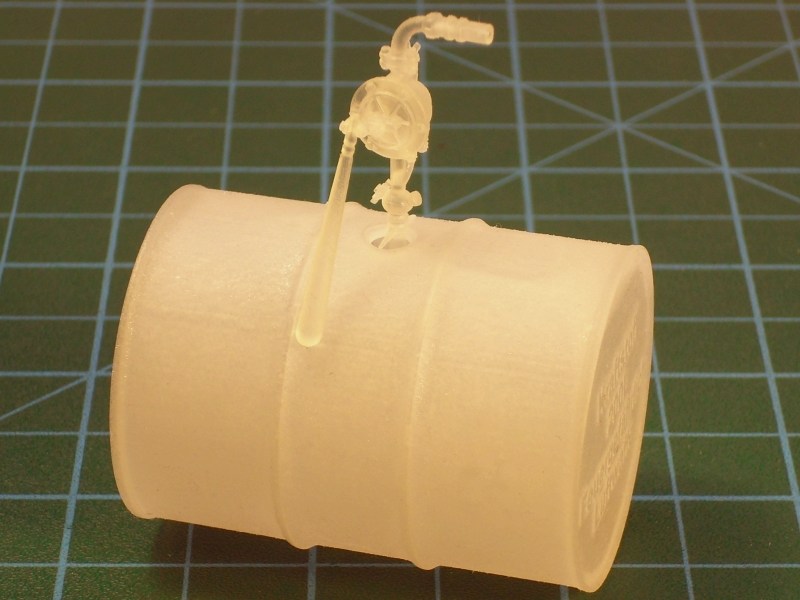
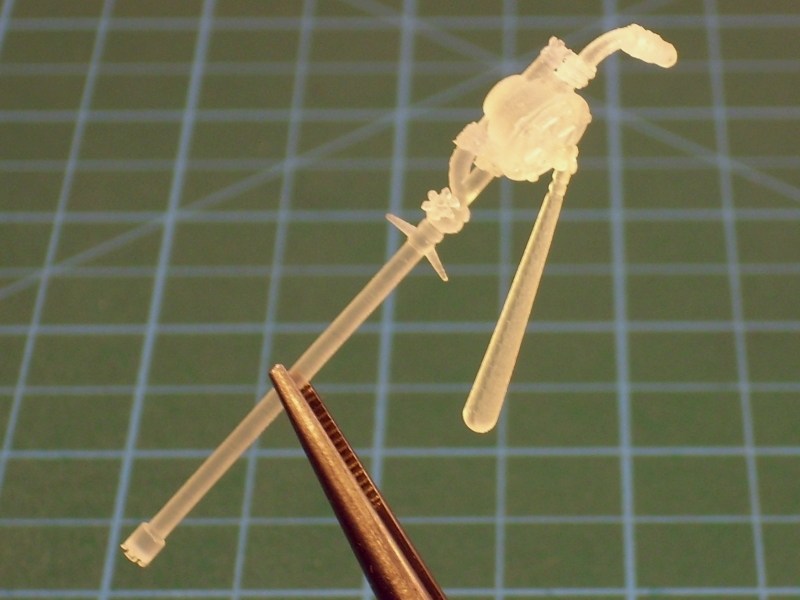
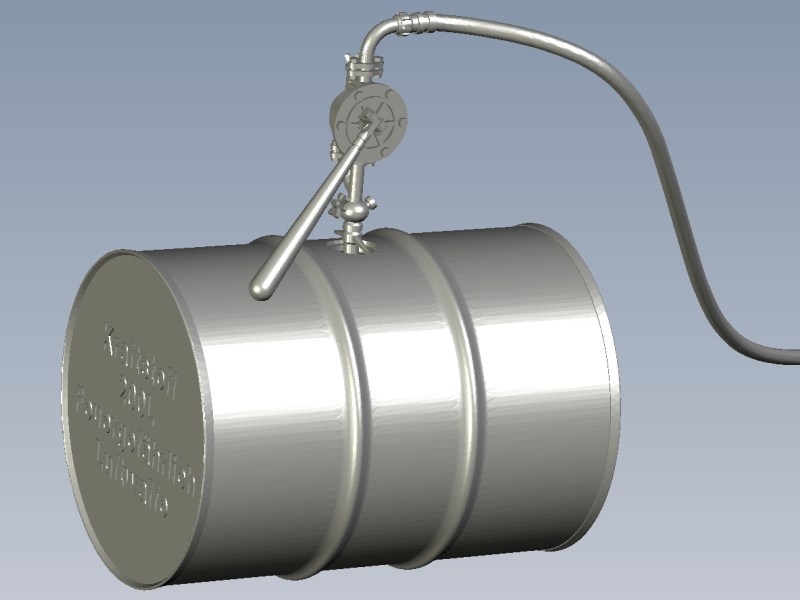
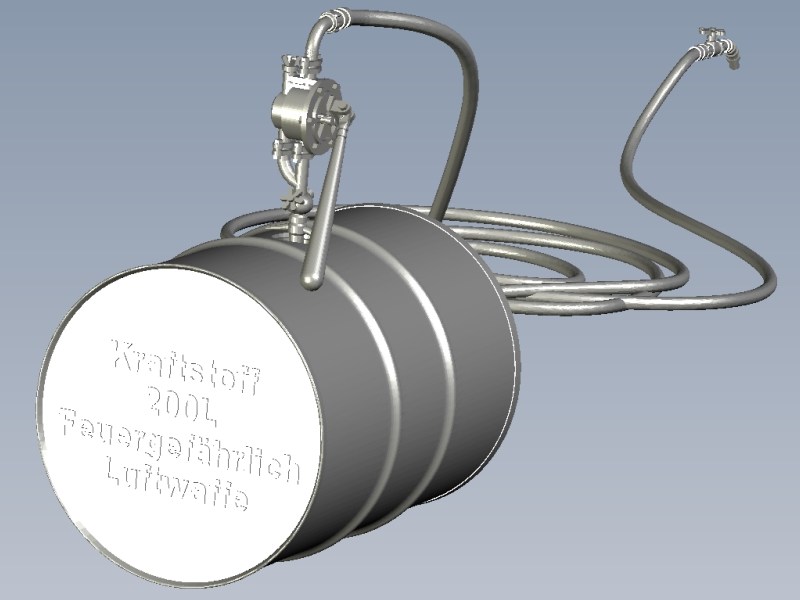
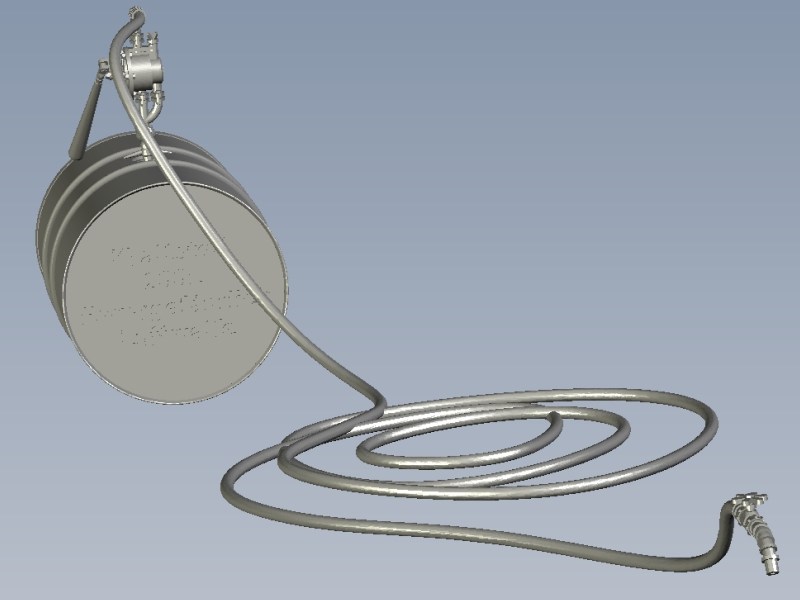
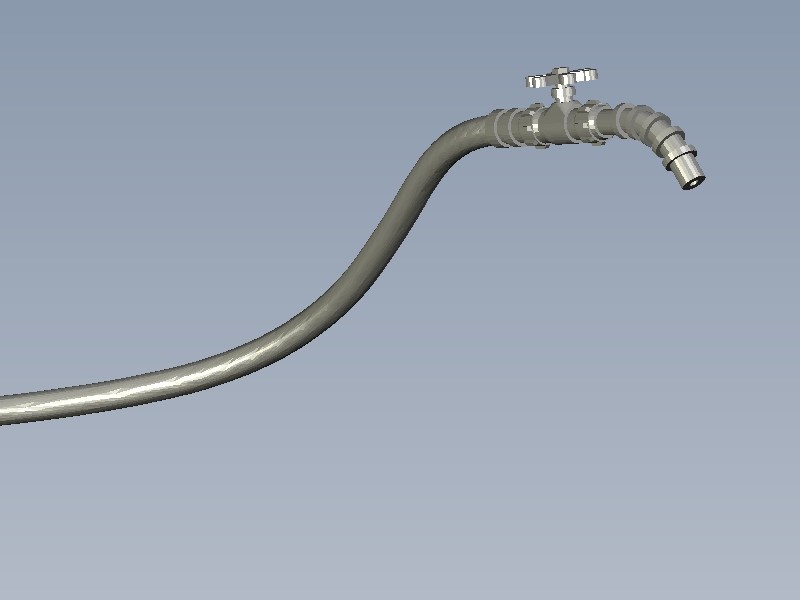
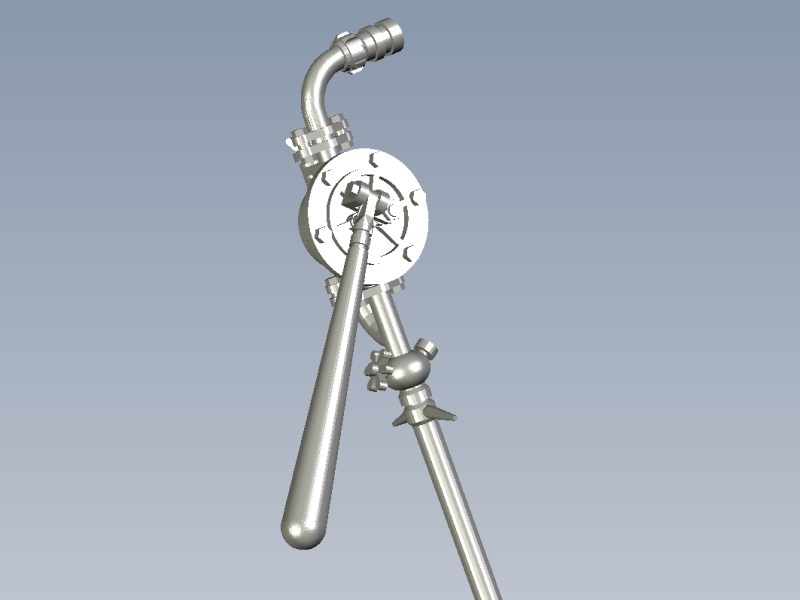
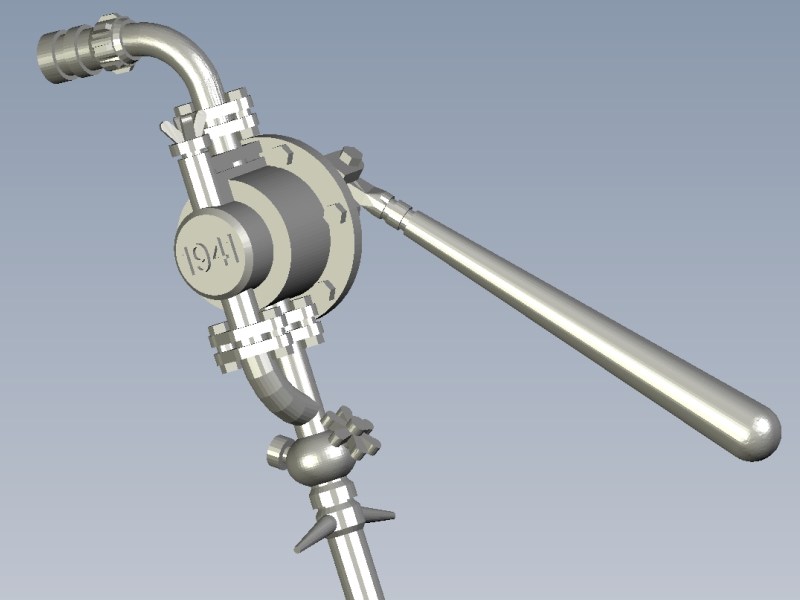 Düzenleyen Nick_Karatzides - 27/07/2018 Saat 12:40 |
|
 |
|
|
Nick_Karatzides
Üye 

Kayıt Tarihi: 06/06/2009 Aktif Durum: Aktif Değil Gönderilenler: 250 |
  Gönderim Zamanı: 18/04/2016 Saat 05:15 Gönderim Zamanı: 18/04/2016 Saat 05:15 |
|
Although 3D printed models do not differ so much from ordinary kits, the plastic material may cause surprises. Some of the kit parts may feel a little greasy and appeat slight traces of oil on their surface. As I've already described into previous pages, it is absolutely normal. After the 3D printing process was finished and the kit parts been removed from the printer tray to be washed into an ultrasonic oil bath and later an ultrasonic water bath, some oil traces escaped the clean inspection and dry by hand procedure. Parts can be easily cleaned by following one of the following methods:
- By washing parts with water (NEVER apply water hotter than 50º C / 125º F or you'll be really sorry) & dishwasher soap and brush gently with an old soft toothbrush. Keep in mind that items are only 0.3mm to 0.5mm thin and they are very fragile. Therefore, being very carefull while washing the parts is a necessary. - By sinking everything into a plastic bowl filled with White Spirit and leave it there for few seconds or a couple of minutes (max) to wash oil traces. In the end the the kit wont feel greasy anymore and show an almost complete white colour. Never use anything more "aggresive" than White Spirit. Also, AVOID stove cleaning spray and acetone nail polish remover products - both clean oil & wax but also dissolve the plastic leading to breakage and failure. - By using hydrosonic cleaning machine (IMHO, is the best alternative), filled with water & dishwasher soap and repeat procedure if needed. Meanwhile the water will turn cloudy - thats the wax. It is of utmost importance that the model parts are properly degreased - otherwise the paint will not stick. Small remainders can be removed with a swab or toothpick. For my own 1/18 scale Kolibri cutaway model kit, I decided (since I do not have a hydrosonic cleaning machine) to wash slight oil traces on parts by sinking everything into a 2 litres plastic bowl filled with White Spirit and leave it there for a couple of minutes. Shortly after all kit parts enjoyed their bath into a White Spirit filled bowl, they were washed with liquid soap & warm water, placed on soft paper towels and allowed to dry. 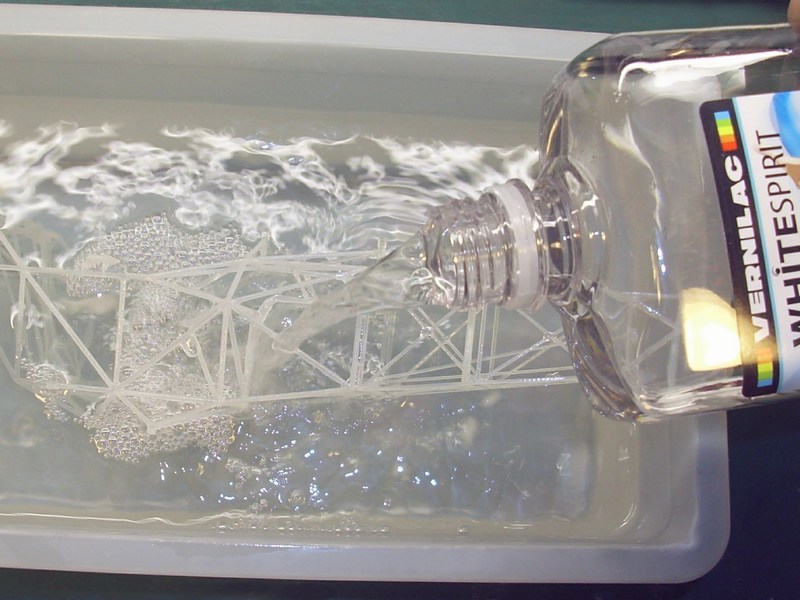
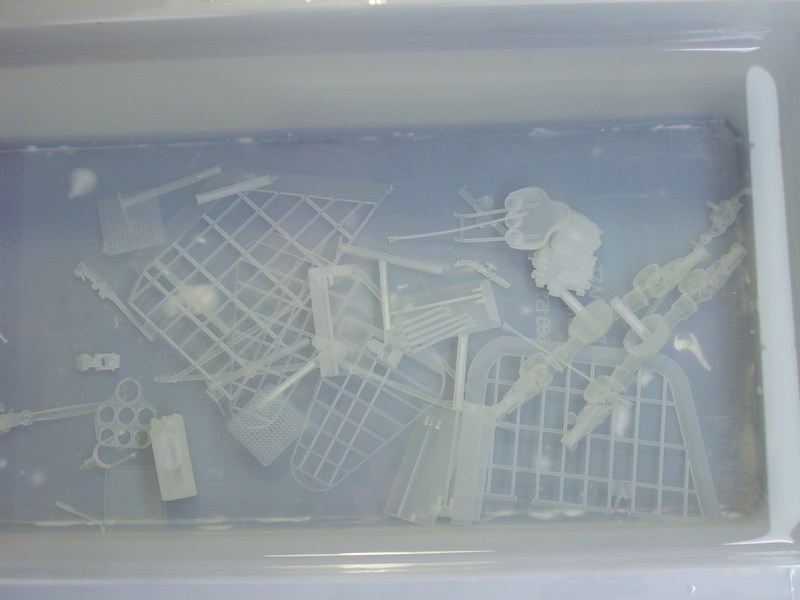
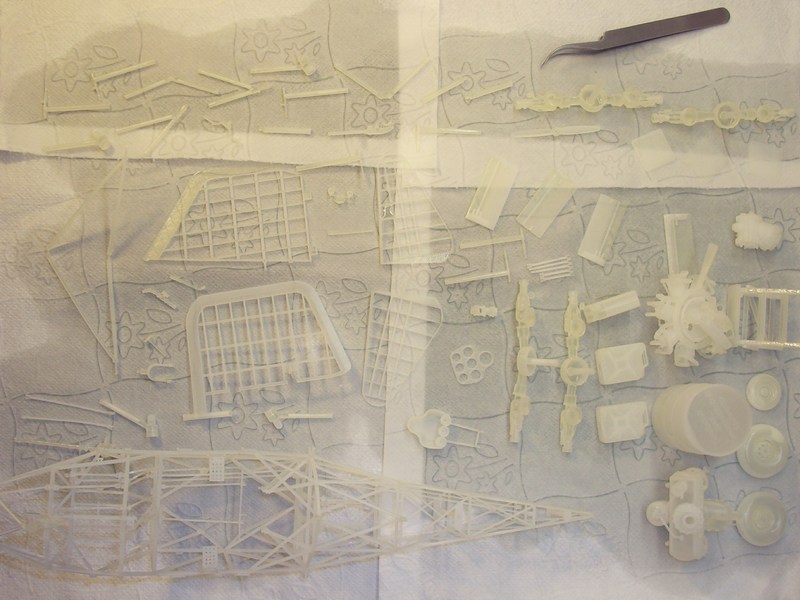 Düzenleyen Nick_Karatzides - 27/07/2018 Saat 12:40 |
|
 |
|
|
Nick_Karatzides
Üye 

Kayıt Tarihi: 06/06/2009 Aktif Durum: Aktif Değil Gönderilenler: 250 |
  Gönderim Zamanı: 18/04/2016 Saat 05:19 Gönderim Zamanı: 18/04/2016 Saat 05:19 |
|
After all kit parts washed in White Spirit & water to clean the oil traces, every section of the model has been repeatedly dry fit tested to ensure that all individual parts could be later combined together as an overall built model. When looked OK to me, each part sprayed over with an undercoat mixture of 80% Life Color LC02 Matt Black and 20% Life Color LC37 Matt Burnt Umber acrylic, to prepare the surfaces for the basic paint which about to follow. Later, a very thin coat of Life Color UA503 Light Blue acrylic paint layer applied, very diluted with Life Colors acrylic thinner in a 30% paint to 70% thinner ratio. The darkest recesses sprayed first, gradually working my way up the frame, keeping to the lighter areas on central parts of each tubular part. Same pattern maintained throughout the entire painting process to preserve continuity with the light source and subsequent spraying sessions continued to utilize very thin Life Color UA503 Light Blue acrylic paint layers as a base to varying degrees because it is the source of the light colour.
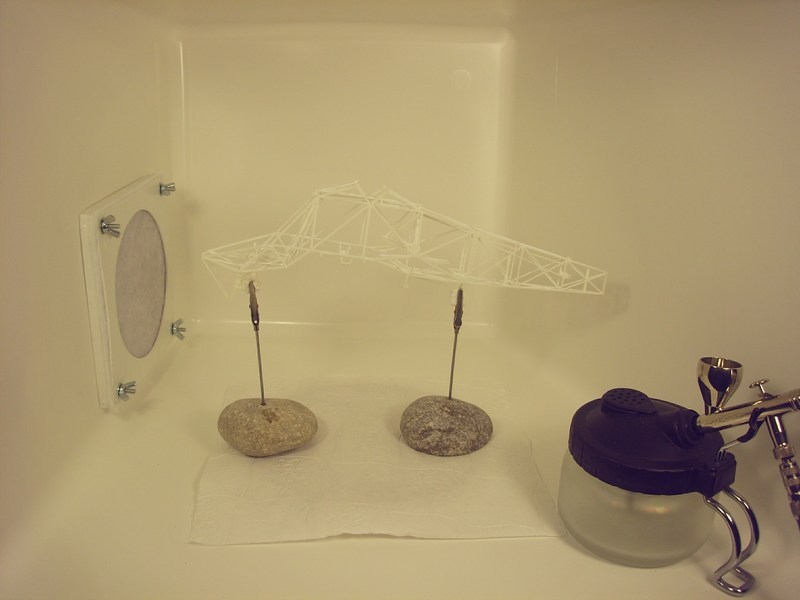 The tubular frame got gradually lighten with each successive layer as the painting process continued, so the second layer of paint as the medium layer of the base coat, is based upon a less diluted 50% paint to 50% thinner ratio. Then, I added just a few drops of Life Color LC01 Matt White FS37925 acrylic paint into the mixture to lighten up this stage of paint application, being very careful to always follow the established gradation pattern, untill contrast between light and dark started to become apparent.  Düzenleyen Nick_Karatzides - 27/07/2018 Saat 12:41 |
|
 |
|
|
Nick_Karatzides
Üye 

Kayıt Tarihi: 06/06/2009 Aktif Durum: Aktif Değil Gönderilenler: 250 |
  Gönderim Zamanı: 16/11/2016 Saat 12:10 Gönderim Zamanı: 16/11/2016 Saat 12:10 |
|
As soon as most individual 3D printed parts on both full fuselage & cutaway scale model kit versions were already painted & weathered, everything should be combined and assembled as an overall built miniature. Having already installed the rudder fin and the two horizontial elevator fins on the full fuselage version models tail, the gear box unit was next. Following instructions described into the building manual (click HERE for the PDF formated file) through pages 33 to 37, all the four pins on gearbox unit should be simultaneously aligned onto the upper frames slots and same time linked downwards with engines transmission shaft, as shown on following pictures. 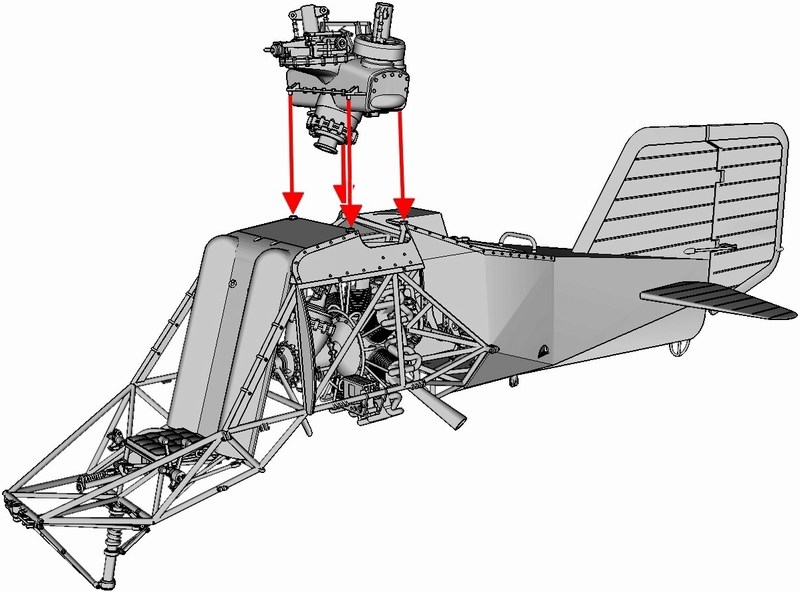
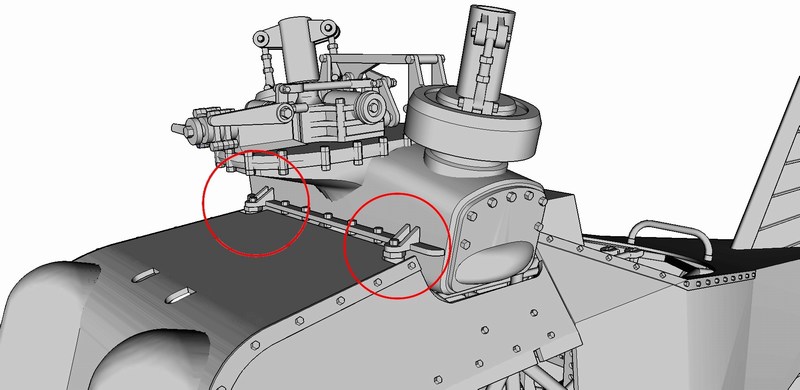 Here is a detailed view of the correctly installed gearbox unit as seen underneath the fuselage cover. Notice that the forementioned gearbox unit is linked (marked with red circle) with previously assembled engines transmission through a shaft coupling. 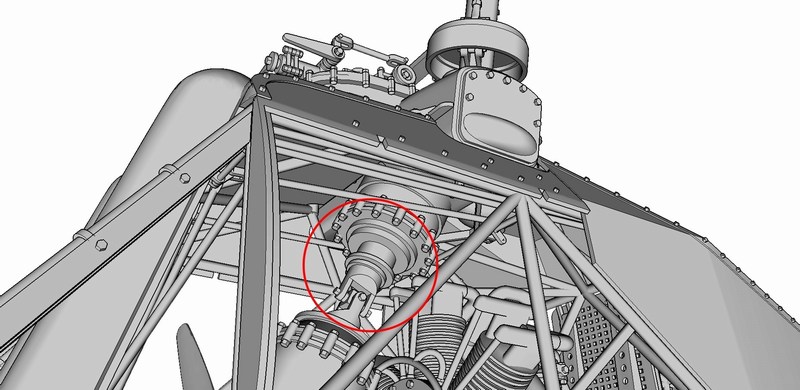 This is how the assembled block of rotary engine, transmission unit, cooling twin blade propeler fan, drive shaft & upper gearbox unit should look like when correctly fit into each other. Notice that tubular frame is not visible here for better example view. 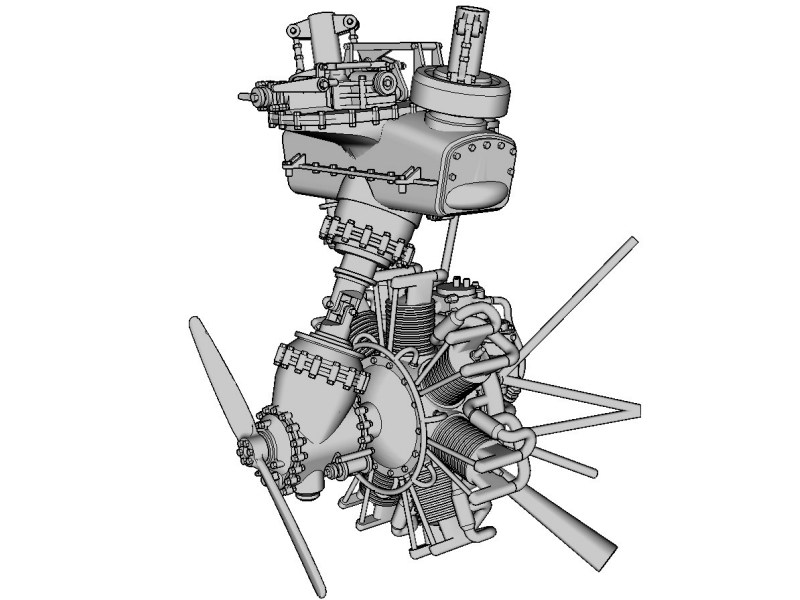 Both full fuselage & cutaway scale model kit versions are equiped with fixed non-retractable tricycle type undercarriage with a steerable nose. The tubular shaped struts & the central supporting section anchoring points aligned on proper U-shaped slots found on the lower fuselage area. Following instructions described into the building manual, the upper & lower anchoring points on each tubular landing gear strut end should be simultaneously aligned onto the tube frames U-shaped slot (marked with red arrows). Successful assembly of main landing gear section will positively affect process to follow - a side tilted helicopter model, would look completely unreal. 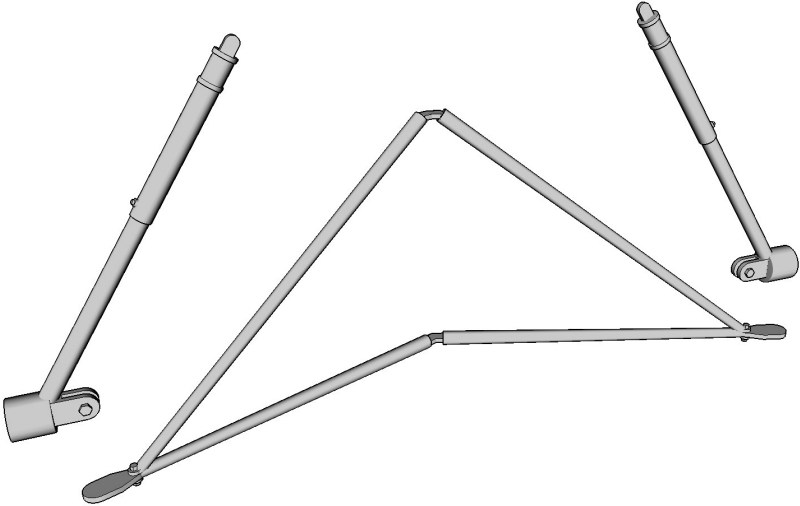
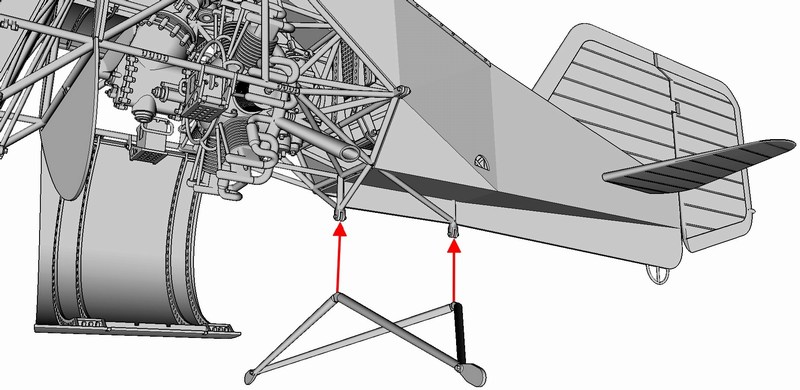
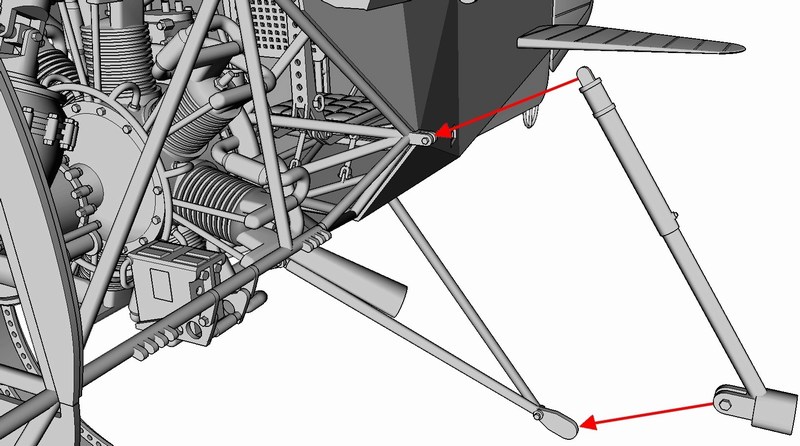 This is how the fixed non-retractable tricycle type undercarriage frame should look like when the parts correctly installed on the fuselage frame. Everything secured in place with a drop of cyanoacrylate super glue. 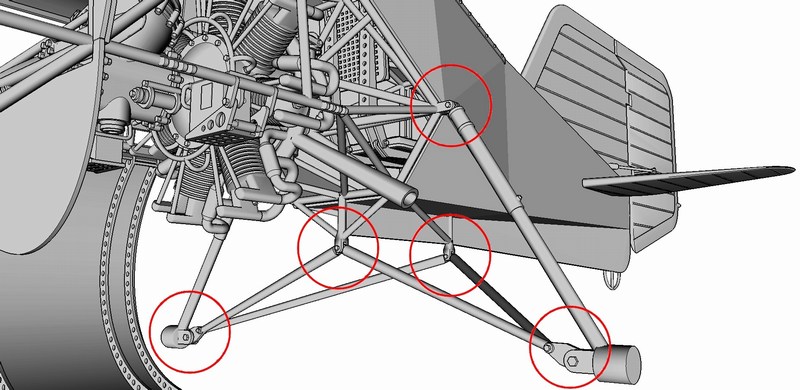 To add some weathered look on fuselage areas (doped fabric covering over the steel & wooden frame on real helicopter) and replicate parts like being dirty, dusty or sunfaded, I appplied different shades of dark brownish pigment powder, trying to blend them nicely to look artistically accepted and create 3D-alike effects on flat surfaces. The results on model may not look so strictly realistic comparing to the real world objects, but IMHO scale modeling has to balance between realism factor and artistic expression. I admit that adding (extensively in some specific areas) pigment powder, may not accurately replicate the reality, but it looks artistically attractive and becomes easily accepted by visual subconscious. 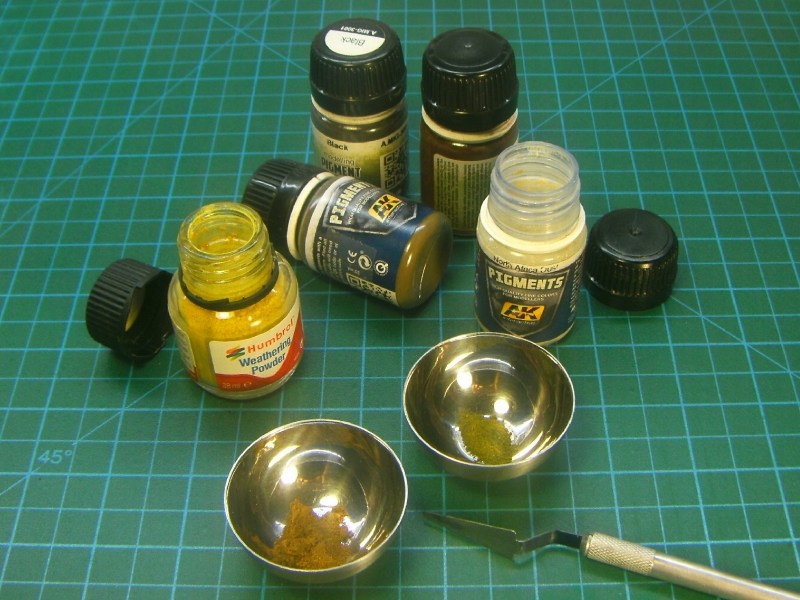
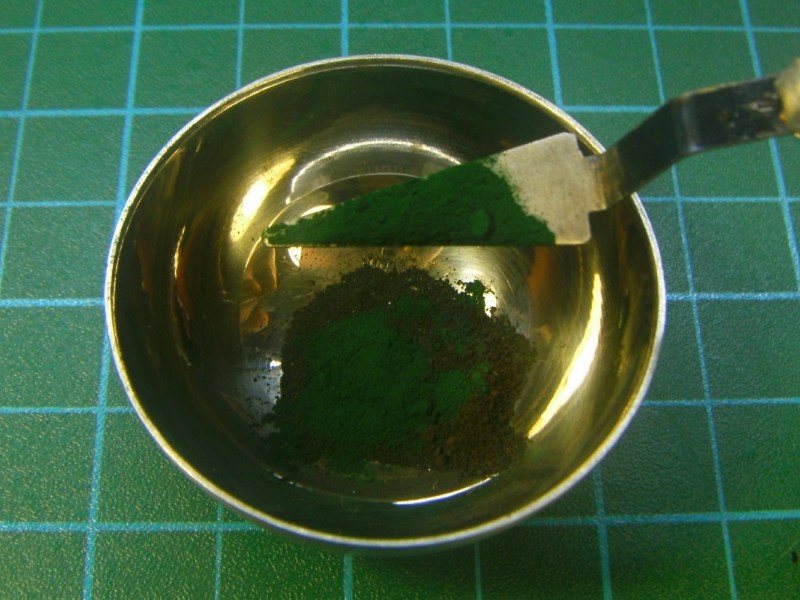

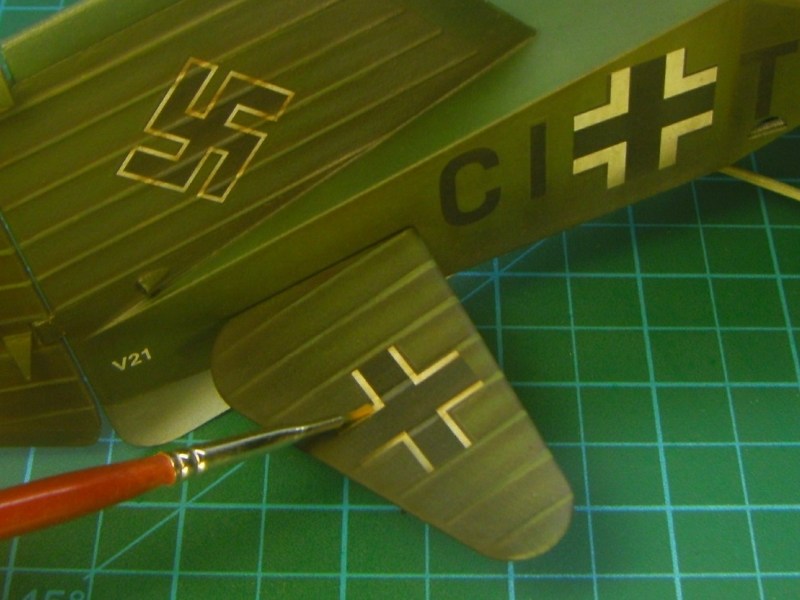 The main advantage of the pigment powder shades is that the already painted scale model gets some nice weathering / lighting effect tones. On the other hand, the big disadvantage is that once the pigment powder settles on the models surface, it should not be touched to avoid smudging. To overcome this problem, modelers usually secure the pigment in place by carefully soaking the model surface with modeling fixer. However, even after applying modeling fixer, it is not absolutely safe to touch the model. 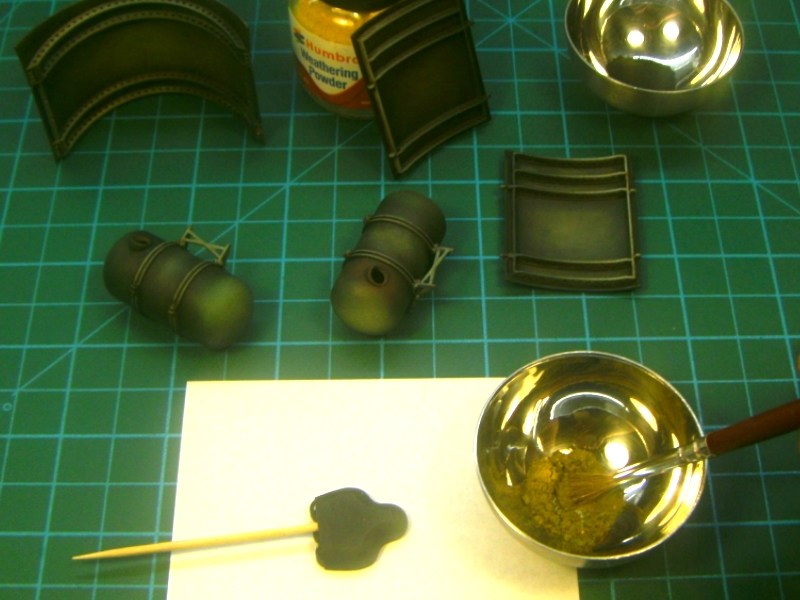
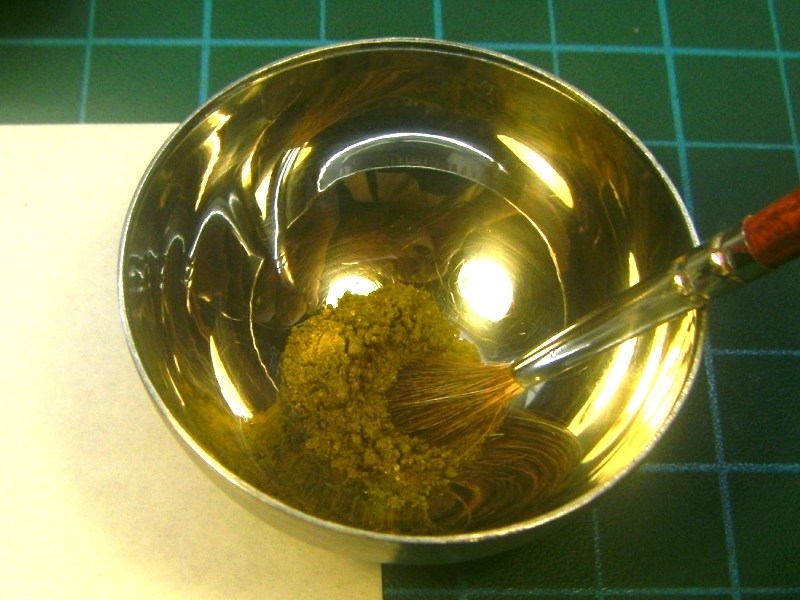
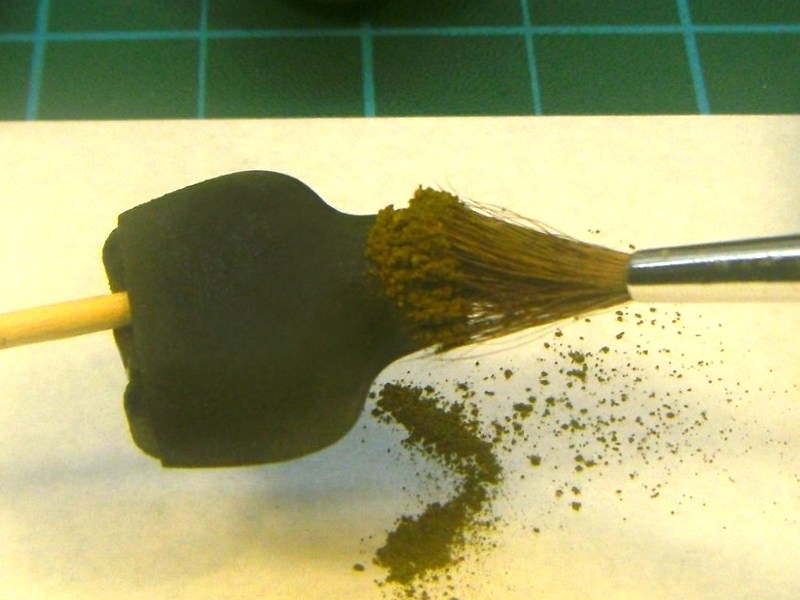
 I tried a different approach and used Winsor & Newtons fixative for charcoal & pastels (instead of modeling fixer) over pigments. Although similar, the Winsor & Newtons fixative is different from the modeling fixer. The Winsor & Newtons fixative solution (available in 75ml and 500ml bottles) provides protection of charcoal, pencil, pastel & chalk drawings - it is mostly used by painters & pastel artists to seal the final result of their work. Although the model paint gets glossy after Winsor & Newtons fixative applying, the good news is that model can be sprayed over with final matte coat after securing pigments with Winsor & Newtons fixative, without leaving disastrous spots or milky stains on model (as usually happens when applying matte coat over modeling fixer-sealed pigments). 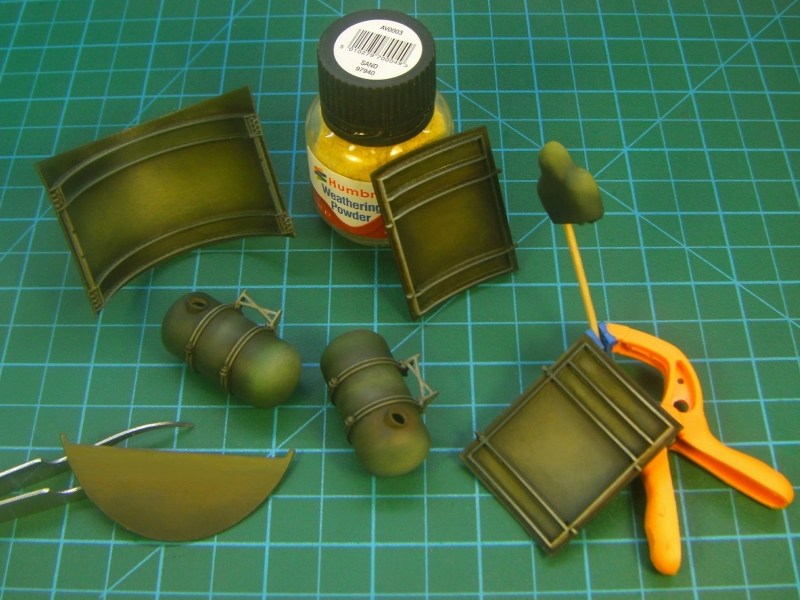 Once the Winsor & Newtons fixative dried, the (glossy) outcome had tonality differences because pigments applied earlier and looked like been faded by the sun, fouled by dust and stained by fuel & oil. As previously mentioned, the glossy look is not actually a problem, since the model can be sprayed over with final matte coat later, while keeping all the pigment shades. 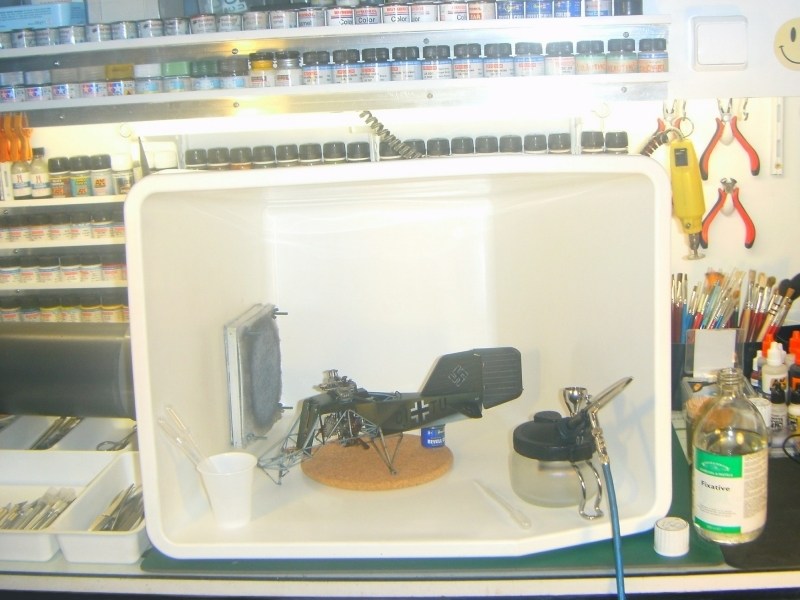
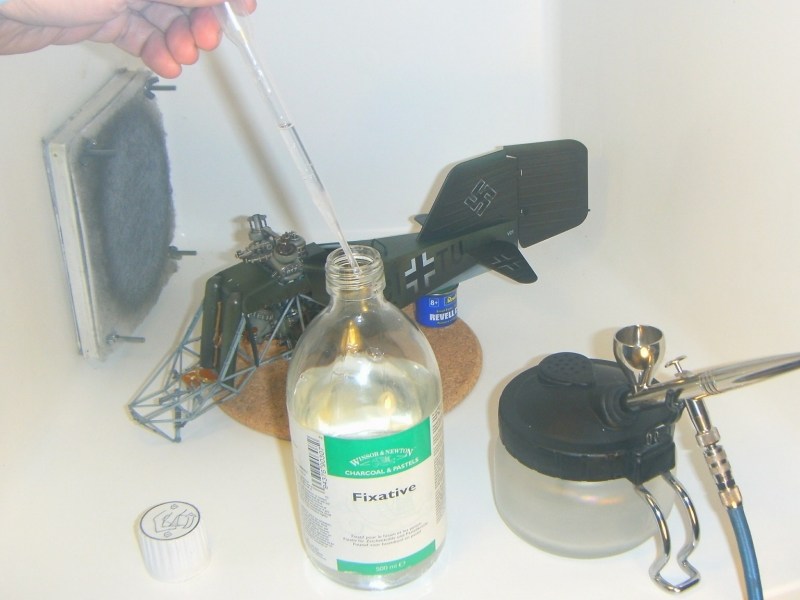
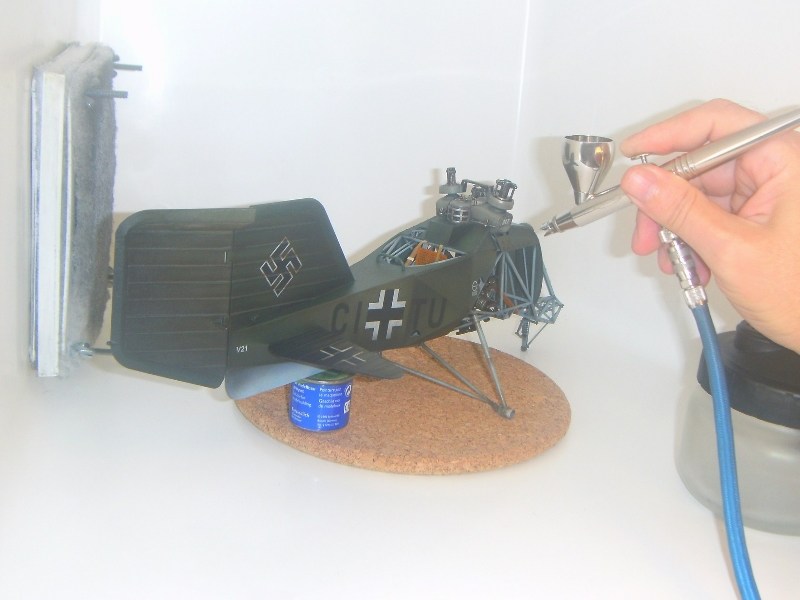
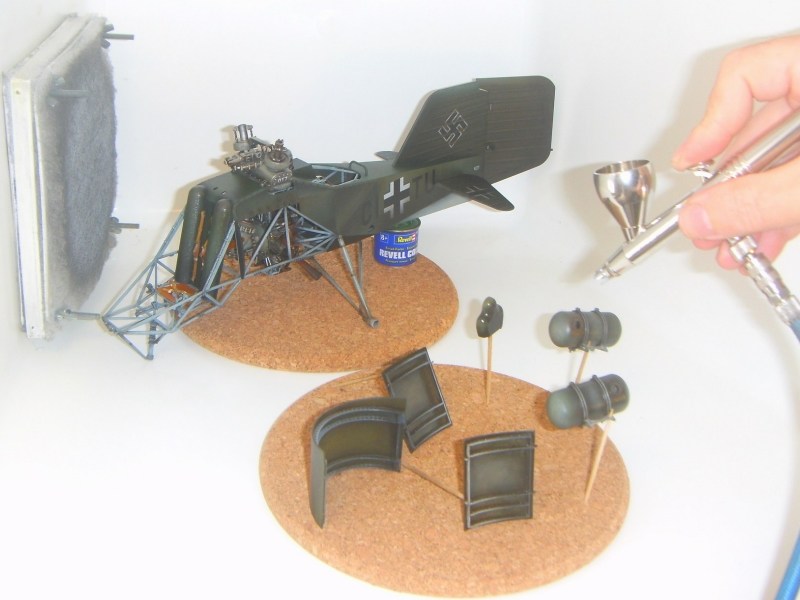
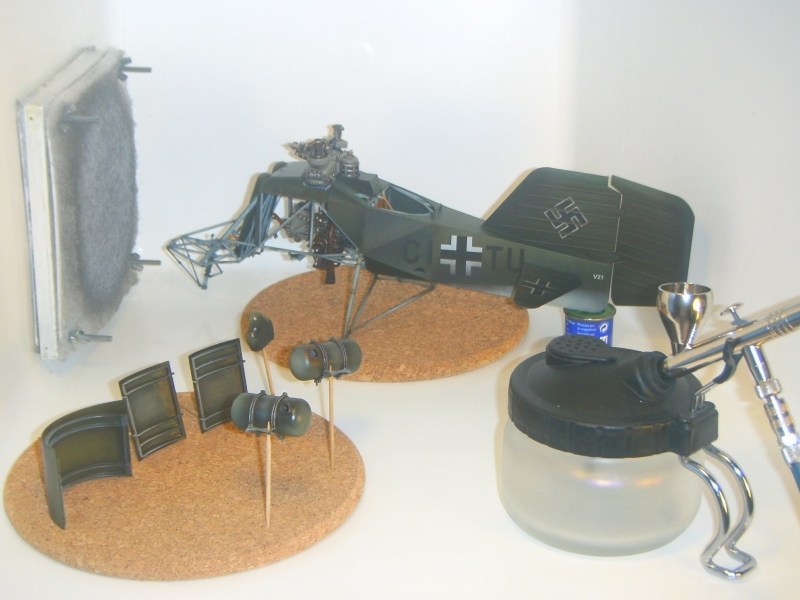 The wheels attached on undercarriage, according instructions described into the building manual. The U-shaped nose wheel supporting fork, pinned into the shock absorber slot while making sure that axes are aligned, as shown in following picture. Notice that nose wheel is tilted accordingly to the rudder fin (which is already installed) as previously explained. 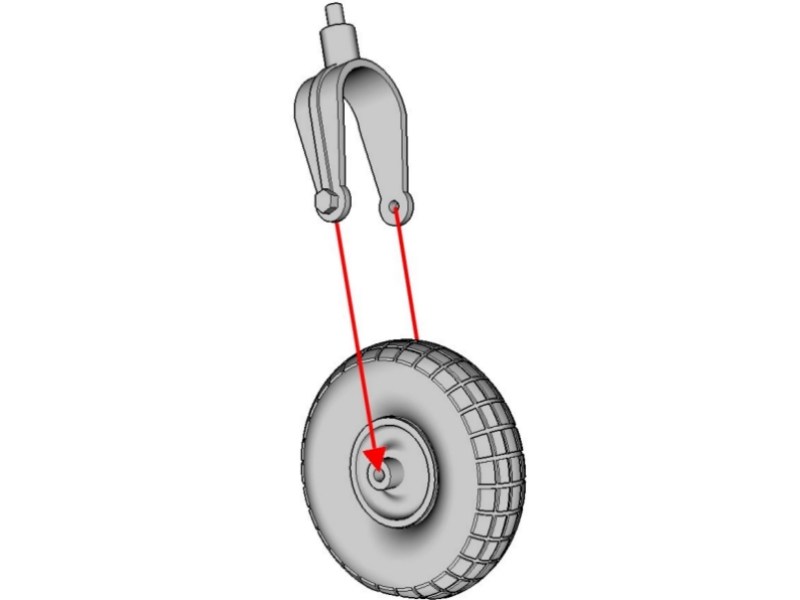
 The twin 25 litres cylindrical fuel tanks (mounted externally on both sides of the pilot seat), attached on frame by plugging pins into proper slots as shown on the following pictures & secured in place with cyanoacrylate super glue. Since these cylindrical fuel tanks are made hollow, the sealing caps can be removed if building a refueling diorama scene. Notice the details marked into the red circles - this is how the cylindrical external fuel tanks should look like when correctly mounted externally on both sides of the cockpit area framework. 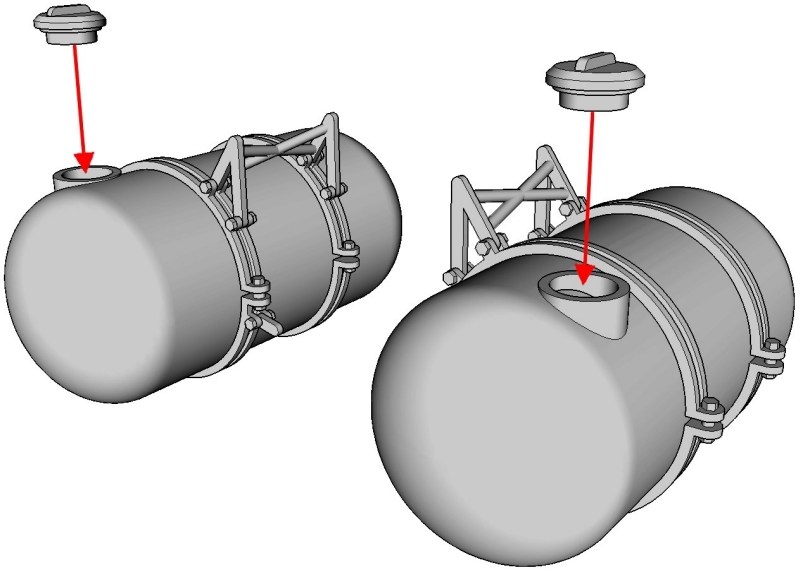
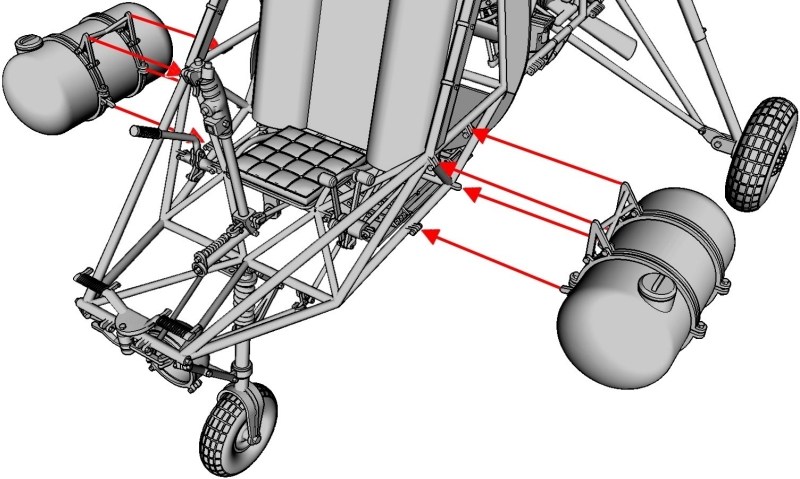
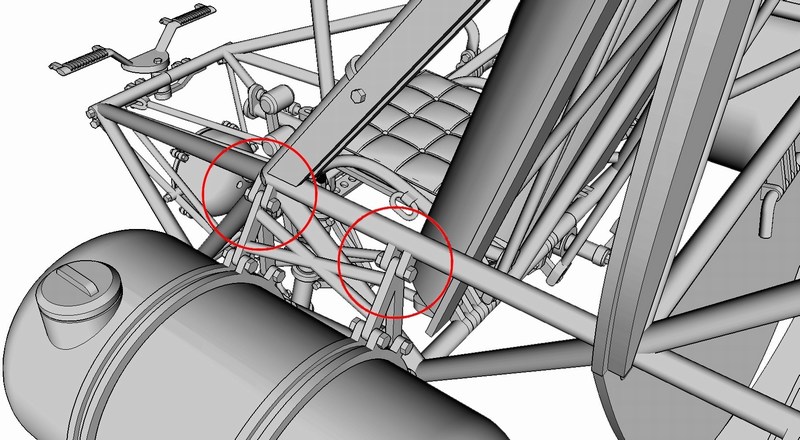 Here is how a semi-built full fuselage scale model kit version looks like as seen underneath, after few of the kit parts installed. More parts such as the side & lower fuselage door panels, the rudder pedals & control levers in cockpit area, the instruments panel, the rotor heads & blades etc, will be attached on main frame later. 
 Düzenleyen Nick_Karatzides - 27/07/2018 Saat 12:42 |
|
 |
|
|
Nick_Karatzides
Üye 

Kayıt Tarihi: 06/06/2009 Aktif Durum: Aktif Değil Gönderilenler: 250 |
  Gönderim Zamanı: 16/11/2016 Saat 12:10 Gönderim Zamanı: 16/11/2016 Saat 12:10 |
|
When I started this Kolibri project for a collector located in Kiel, Germany and later built more identical helicopters for other customers and my own collection at home too, I was concerned about a proper display option, on which the model would be placed. My goal is to build up a simple diorama scene, which looks like a maintenance & refueling area on a forwarded airfield. From an artistic point of view, a maintenance & refueling area scene might possibly dictate everything to be into a state of complete engine oil n grease messiness. My goal is to keep the Kolibri helicopter as protagonist into the scene, while filling the empty space with few maintenance & refueling area related items, to maintain a visual balance. What I am actually trying to present here, is an intentional setup to show scale models details through opened maintenance panels, opened hatches, removed engine unit etc without extreme diorama action, nothing that could possibly distract viewers attention from the Kolibri helicopter which is always the main protagonist of the story. Any other item should be standing as an uninvolved walkon to simply complete the directorial picture. 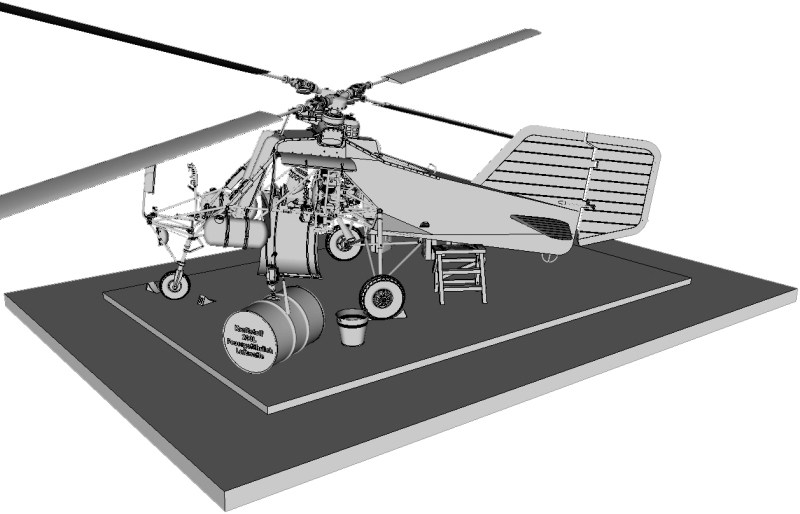 While scale model painting was underway, I thought as good idea to place the Kolibri helicopter scene on a grass airfield area. My opinion had been probably shaped (aka influenced) by viewing WWII era pictures, where the Flettner Fl-282 V21 Kolibris were stationed on the fresh green grass. Unfortunatelly, the problem that would arise from such a choice, is that the (already painted green) helicopter would be visually lost into this greenish backround. Due this reason, the idea of placing the Kolibri model on grass abandoned and the idea of a concrete covered airfield apron area (with just a few short grass sprouted between concrete slabs) where pre-flight activities were done, seemed much better. The scene would require at least a 450 x 350mm display base, considering that helicopter measures approx 357mm long and 138mm wide, without counting the rotor blades with disc diameter approx 700mm each. Those who have read my previously uploaded projects, might remember that I prefer using plaster powder to build the section that recreates the ground, especially if it is asphalt. However, the 450 x 350mm dimensions of the scene dictate plaster quantity more (and therefore heavier) than usual and for this reason I chose to use another material, because the goal was to build a airfield display base instead of weightlifting equipment for champs. For this reason, I decided to follow a different way, by replicating concrete covered airfield apron with cork sheet. I purchased two 500 x 500mm sized & 4mm thick sheets of cork from my local hobby shop, which I cut & shaped around with my Black & Decker 400W / 3000spm jigsaw. The basic idea, is to build an approx 8mm thick & flat surface which protrudes above the polished wood display base, on which short vegetation (grew between the concrete slabs) and diorama accessories (such as maintenance tools, fuel canisters etc), will be added later. 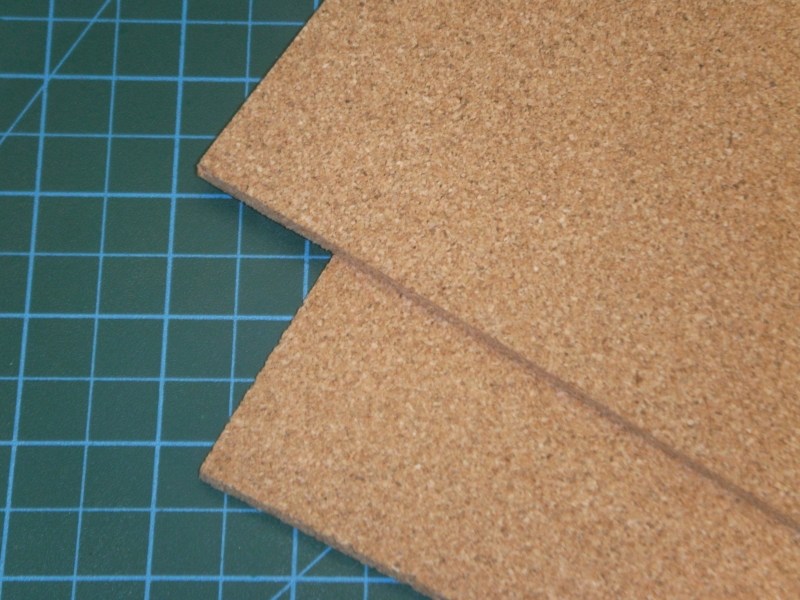 As soon as the 4mm thick sheets of cork identically cut into shape, sandwitch glued and the concrete plaques were lined, I used my airbrush to paint it. As I usually like to do, three different acrylic paint layers were applied on the concrete apron surface. First, mat black colour covered the area and then lighter greyish and earth layers applied, while airbrushing in almost zero degrees angle, to let the darker areas between the concrete plaques remain naturally dark. 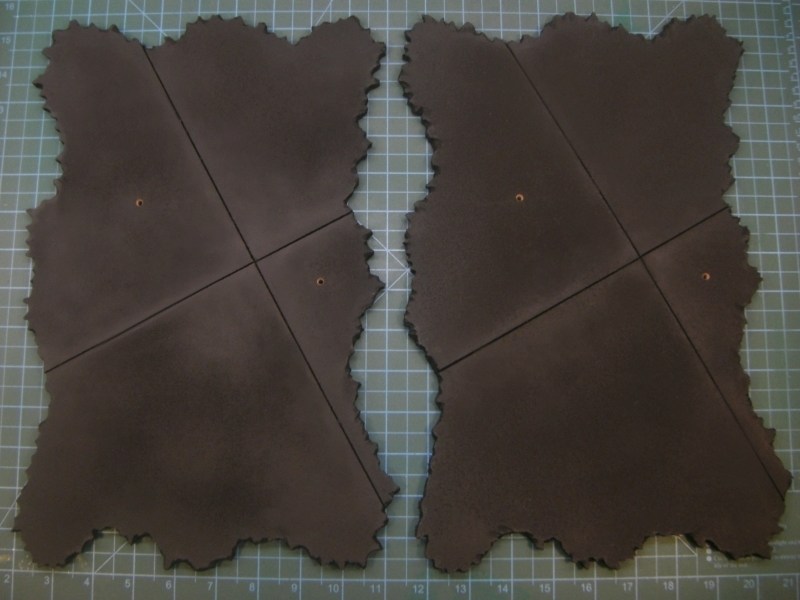 The concrete apron surface was paint with different greyish & earth tones and as soon as the acrylic colours dried, I tried some drybrushing on selected spots using sand tones. Concrete areas on which the oil drums, the fuel canisters, the under maintenance radial engine etc will be placed later (probably resulting oil & fuel stains on ground), painted differently with more yellowish shades to replicate sawdust spread to absorb leaked oil & fuel. As for the vegetation that grew between the concrete slabs, I used some Heki static grass, secured in place with water based white glue for wood which becomes transparent when it dries. When it looked OK to me, I sprayed over with Humbrol enamel matte coat, to seal the paint & vegetation result so far and left it overnight to dry.  Meanwhile, some of the earlier described 3D printed items (unrelated to the helicopter structure) such as few 1/18 scale 20 litres fuel canisters, one of these 1/18 scale 55 gallons oil drums and one of these 1/18 scale 200 litres fuel drums as used by Wehrmacht, Luftwaffe & Kriegsmarine during WWII with Kraftstoff 200L Feuergefährlich Luftwaffe & Kraftstoff 20L Feuergefährlich 1941 inscriptions engraved or embossed on side, also got some paint, dirt & weather effects. All the above mentioned diorama accessories are listed into Anyuta 3D products catalog and available for sale under various scales and sizes. 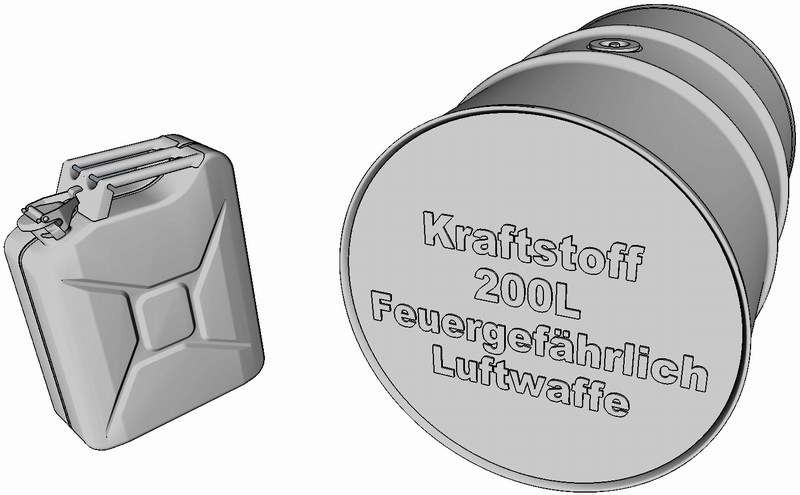 The previously mentioned 1/18 scale 200 litres fuel drum received a basic layer of Life Color UA505 RLM 79 Sandgelb II / Sand Gold II acrylic paint and the 1/18 scale 55 gallons oil drum painted with Life Color UA504 RLM 02 Grau / Grey acrylic paint and allowed to dry overnight. 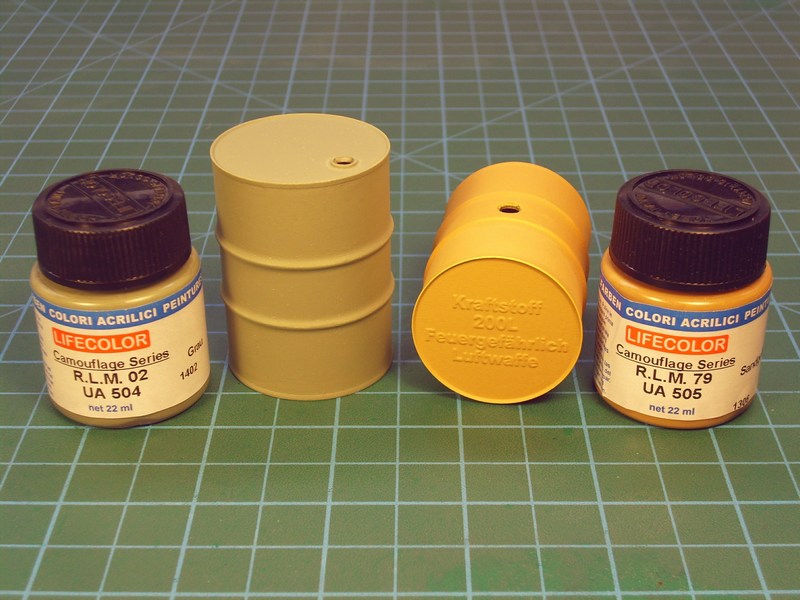 Once the acrylic base coat has cured, both drums got some weathering, paint scratches and rusty chipping effects while using the sponge technique to give visual interest to the base colour. To achieve best results, I did use a fine textured sponge like those used for packing of electrical items. Fresh rust marks also added in some selected points, with some of the Life Color UA704 Rust Light Shadow 2 acrylic. Using a fine tipped brush, the Light Rust Brown & Dark Rust oil paints by 502 Abteilung & AK Interactive series painted in vertical lines from various chips and scratches added earlier. Once the oil paints had been allowed to dry for a short while, a brush dampered in White Spirit used to blend and soften these streaks for a more subtle effect and obtain visible signs of wear & oxidation. 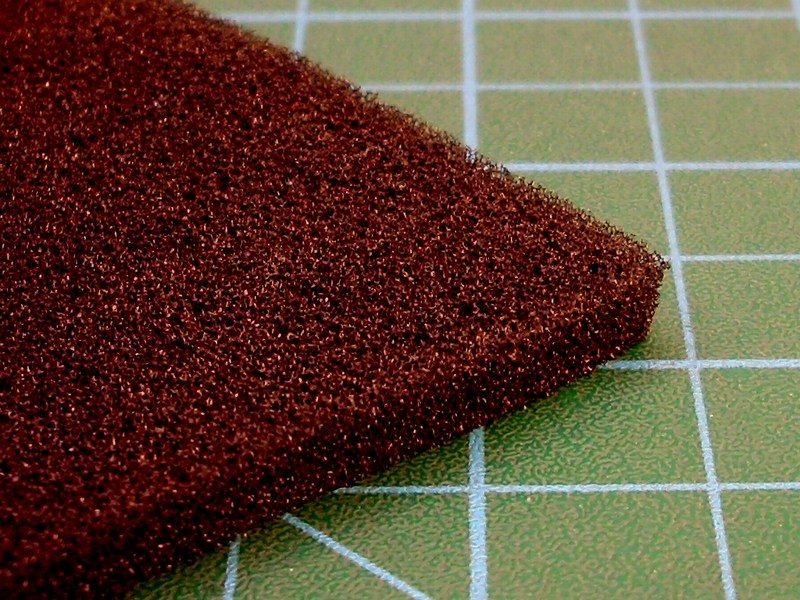
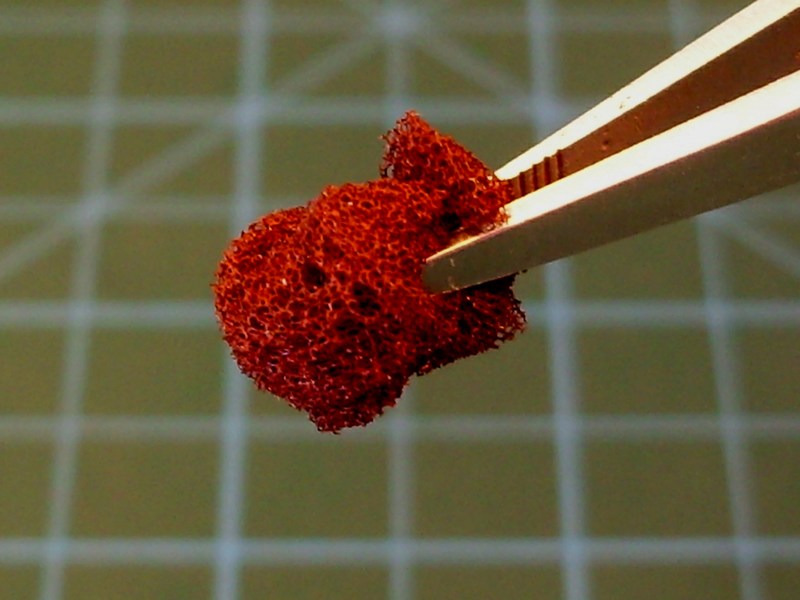
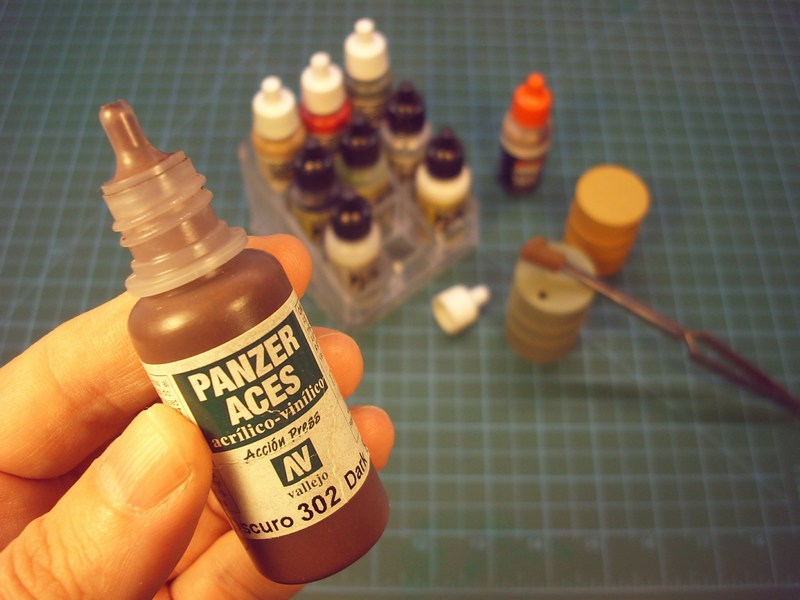
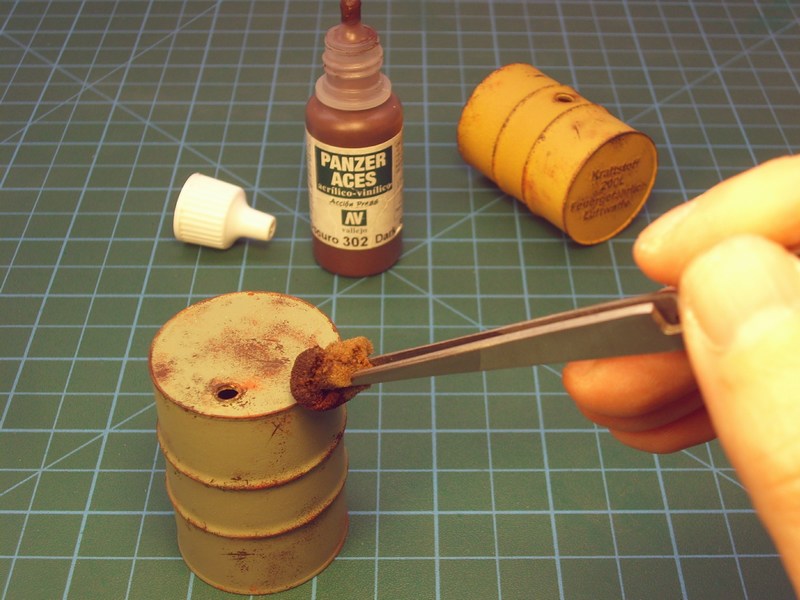 Düzenleyen Nick_Karatzides - 27/07/2018 Saat 12:42 |
|
 |
|
|
Nick_Karatzides
Üye 

Kayıt Tarihi: 06/06/2009 Aktif Durum: Aktif Değil Gönderilenler: 250 |
  Gönderim Zamanı: 17/11/2016 Saat 14:35 Gönderim Zamanı: 17/11/2016 Saat 14:35 |
|
The helicopter model secured in place, by wedging the pins under the wheels into holes that had been already opened on concrete (that's the reason wheels had pins underneath). Once the Kolibri placed on display, each one of all these previously mentioned 1/18 scale items & diorama accessories also secured on ground with hidden metal pins and glued with transparent silicon. Finally, few more maintenance & refueling area related items (such as one 1/18 scale WWII era fuel hand pump, a set of 1/18 scale wheel chocks, some 1/18 scale wooden crates and a couple of 1/18 scale water buckets) also prepared to be placed on concrete display base. A last moments addition, an also 3D printed 1/18 scale WWII era Fahrrade M30 reconnaissance duty bicycle model, prepared for the diorama display.
All the above mentioned diorama accessories are listed into Anyuta 3D products catalog and available for sale under various scales and sizes. 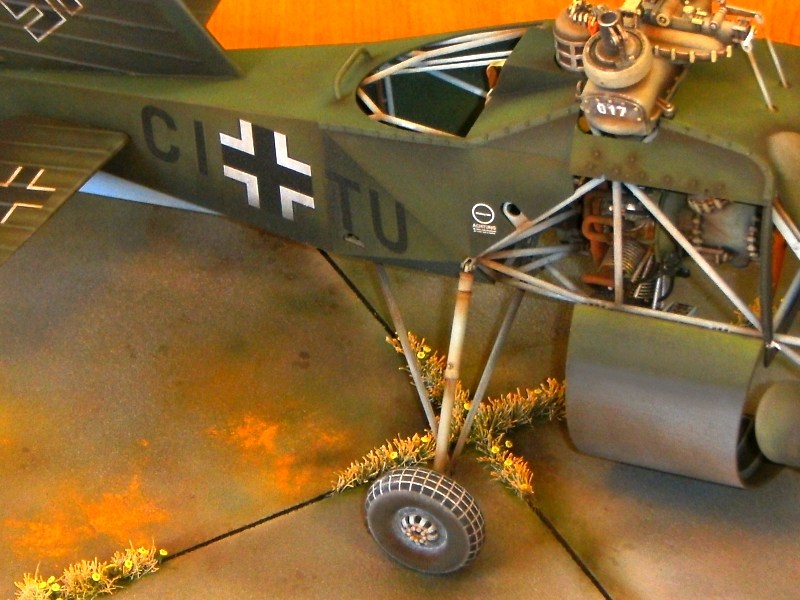

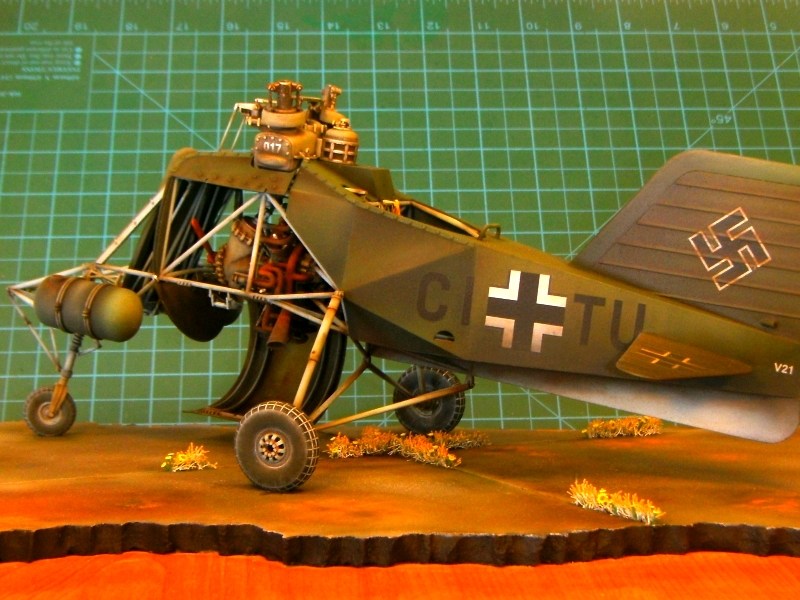
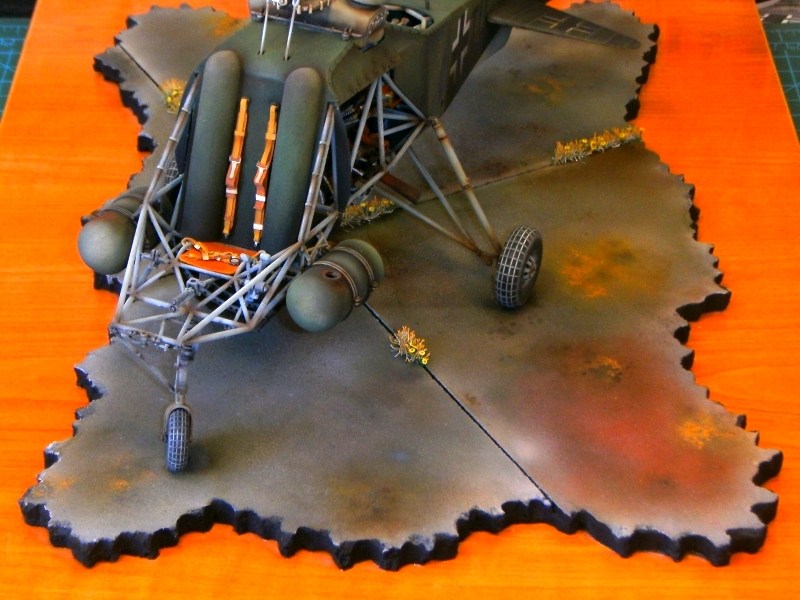
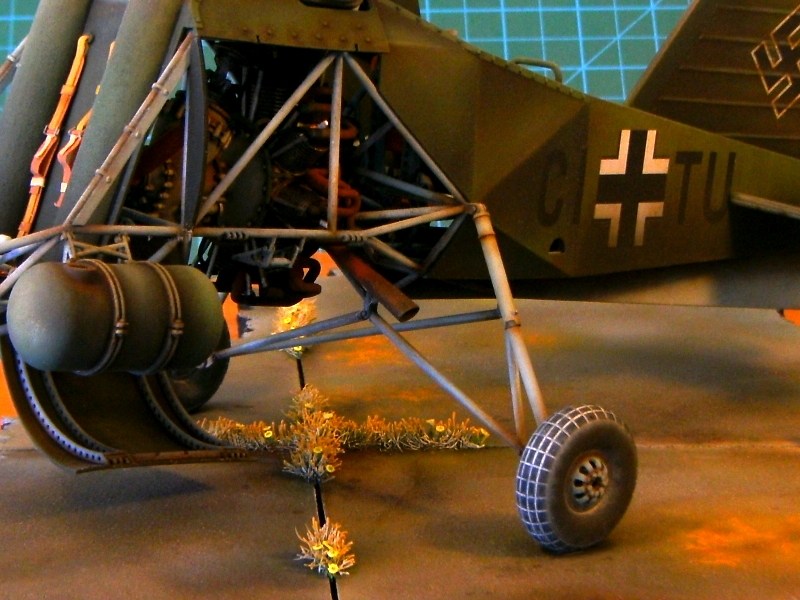
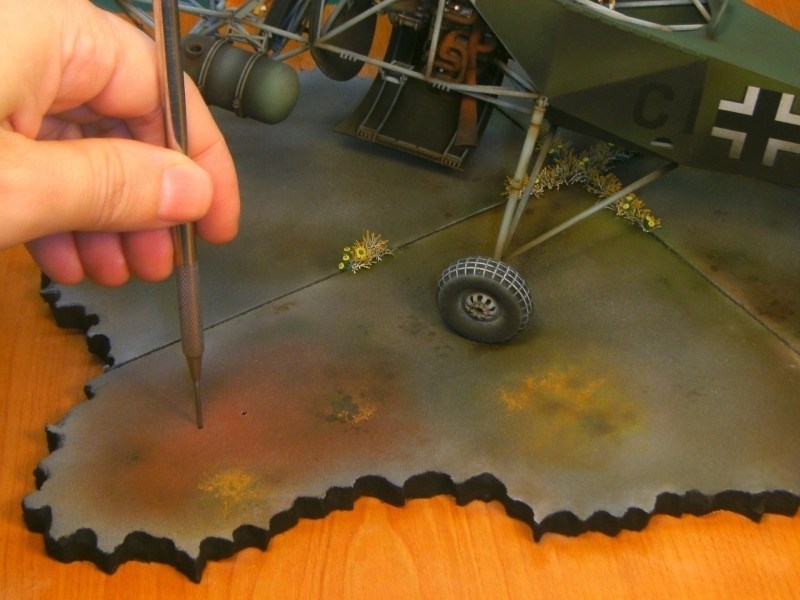
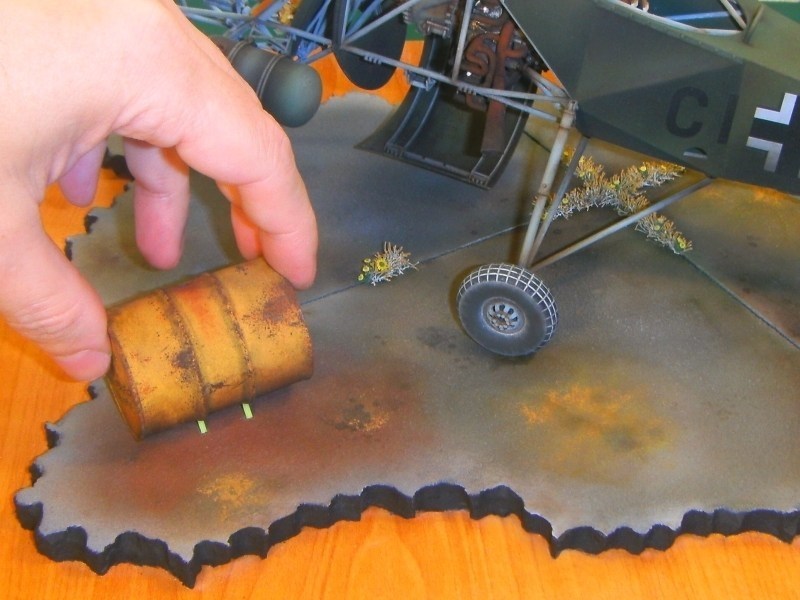 Düzenleyen Nick_Karatzides - 27/07/2018 Saat 12:43 |
|
 |
|
|
Jolly Roger
Üye 
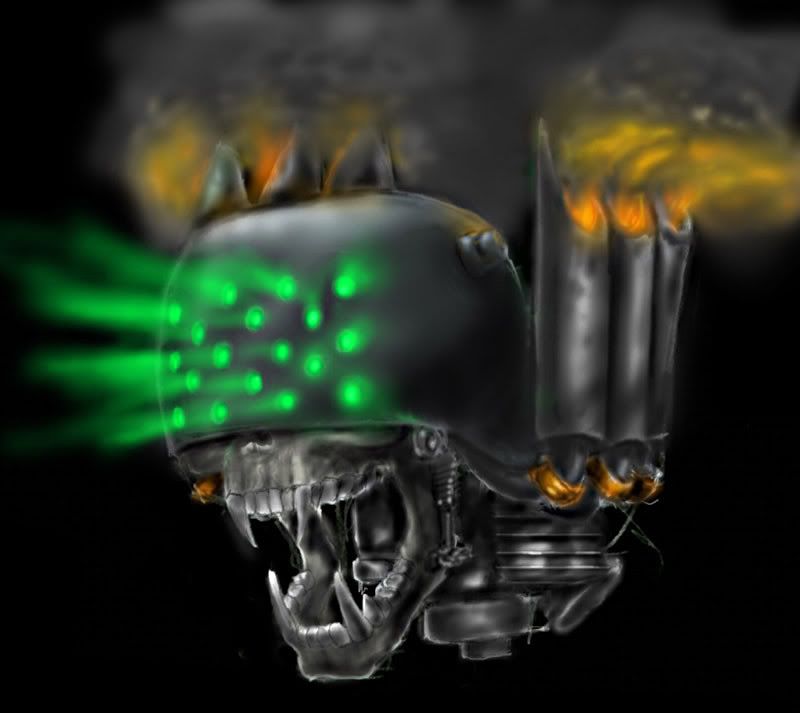
Kayıt Tarihi: 18/08/2005 Aktif Durum: Aktif Değil Gönderilenler: 2436 |
  Gönderim Zamanı: 28/11/2016 Saat 19:53 Gönderim Zamanı: 28/11/2016 Saat 19:53 |
|
There are times I am honestly speechless. All I can say is that I am not a fan of the colours you used on the apron and the shading on the crosses are a tat much but hey, that is my personal view. Superb work.
|
|
|
Consume Ergo Sum
|
|
 |
|
|
Nick_Karatzides
Üye 

Kayıt Tarihi: 06/06/2009 Aktif Durum: Aktif Değil Gönderilenler: 250 |
  Gönderim Zamanı: 27/07/2018 Saat 12:44 Gönderim Zamanı: 27/07/2018 Saat 12:44 |
|
Been long time since last visit, huh? Well, let's remember some hobby fun again. :)
The objective is to build two different diorama scenes for two different versions of the same helicopter: - One for the full fuselage version of the 1/18 scale Flettner Fl-282 V21 Kolibri model kit and, - A second for the cutaway / fabric stripped version of the 1/18 scale Flettner Fl-282 V21 Kolibri model kit. According to plan, both of them would include few additional features without distracting viewer's attention, keeping the Kolibri helicopter as the main protagonist of the story. Starting with the full fuselage version, the addition of a WWII era Luftwaffe's 200 litres fuel drum with a handpump attached, few 20 litres canisters and a filled bucket left on ground, seemed good idea to me in order to present a short refueling scene. 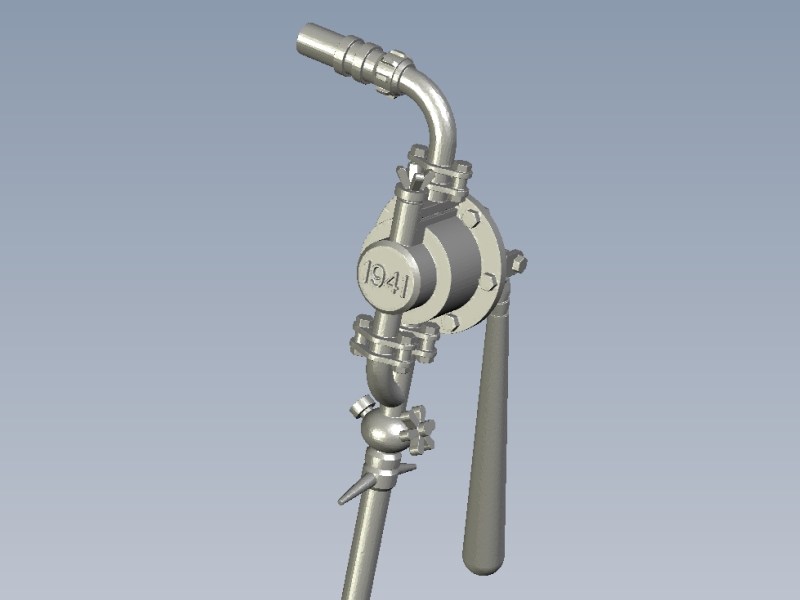
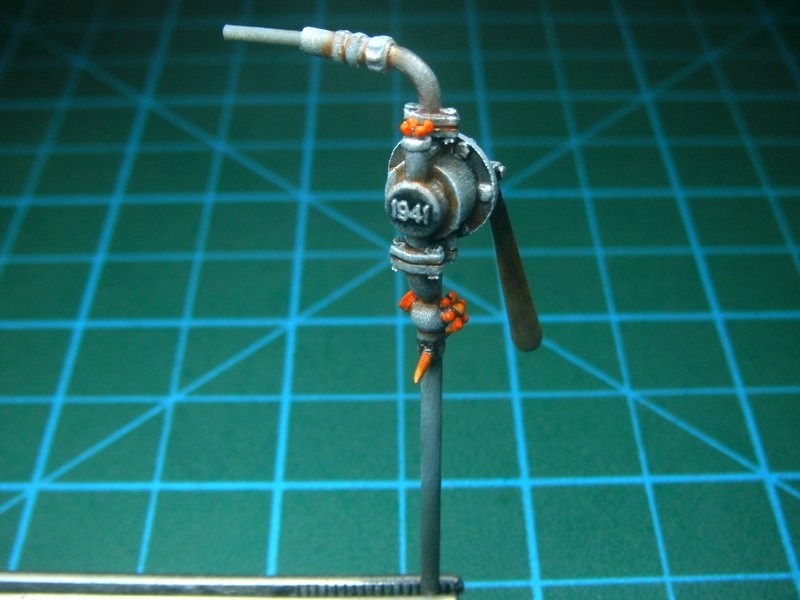
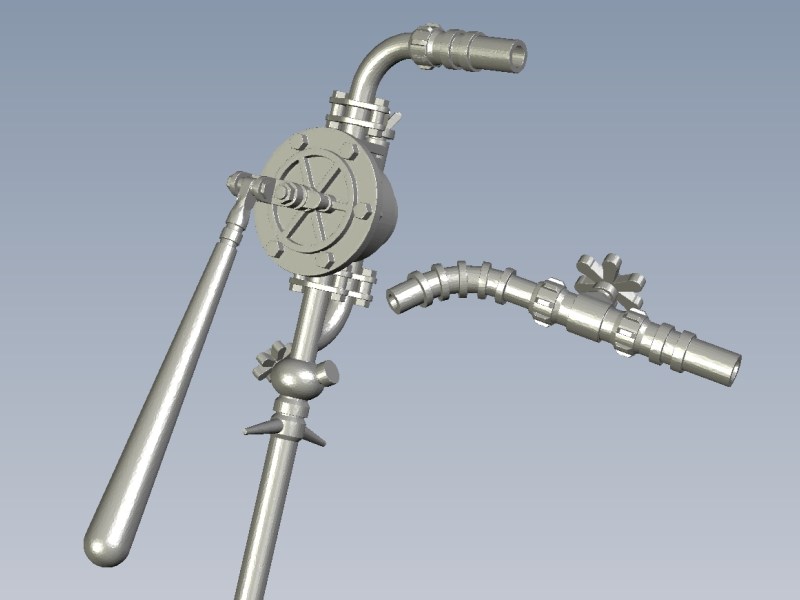
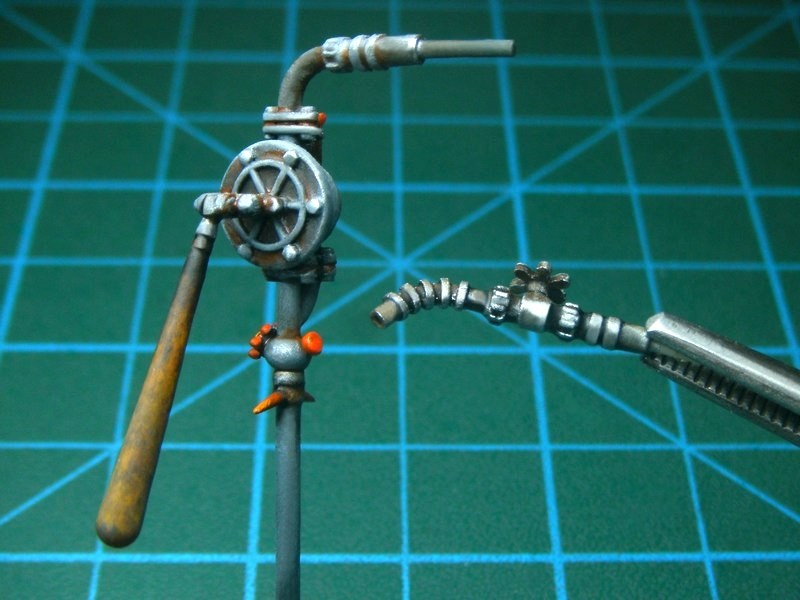

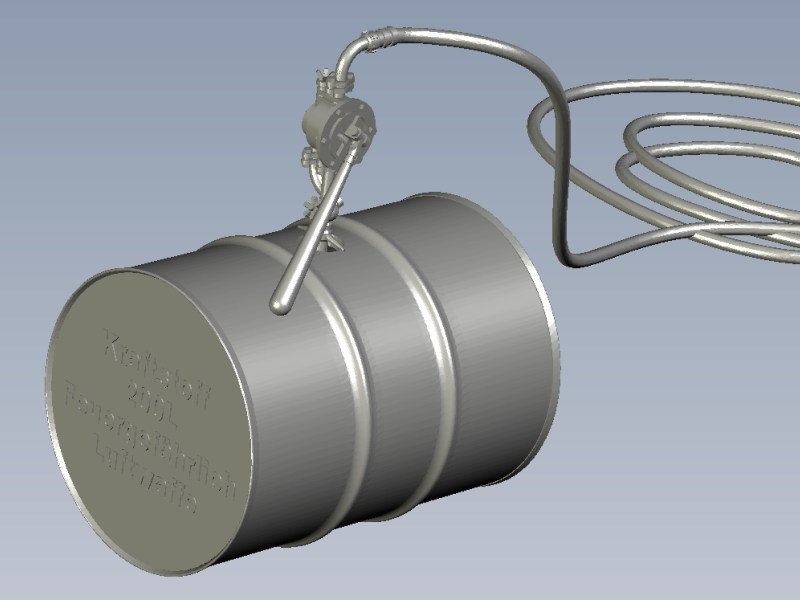
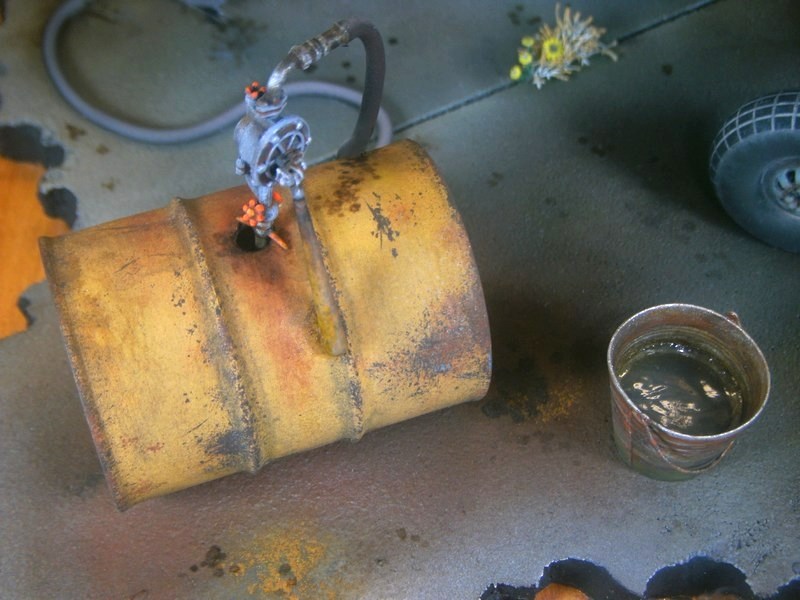
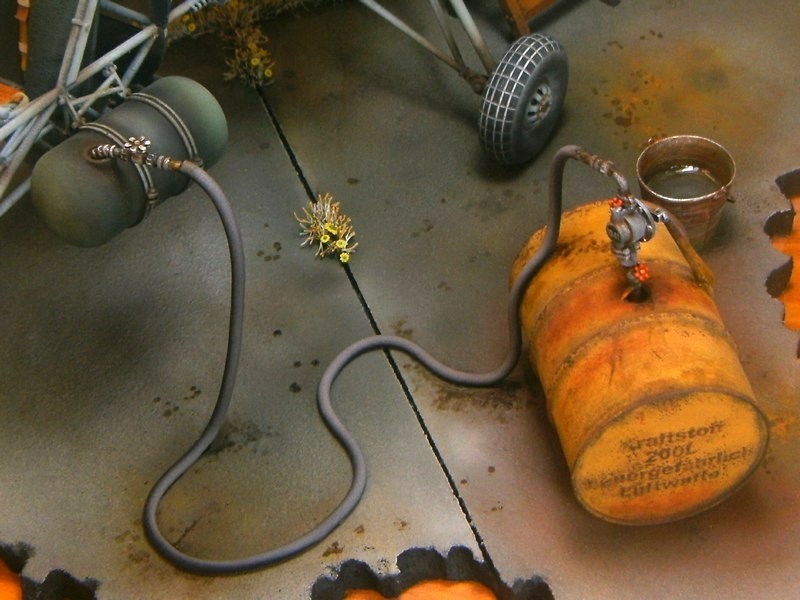
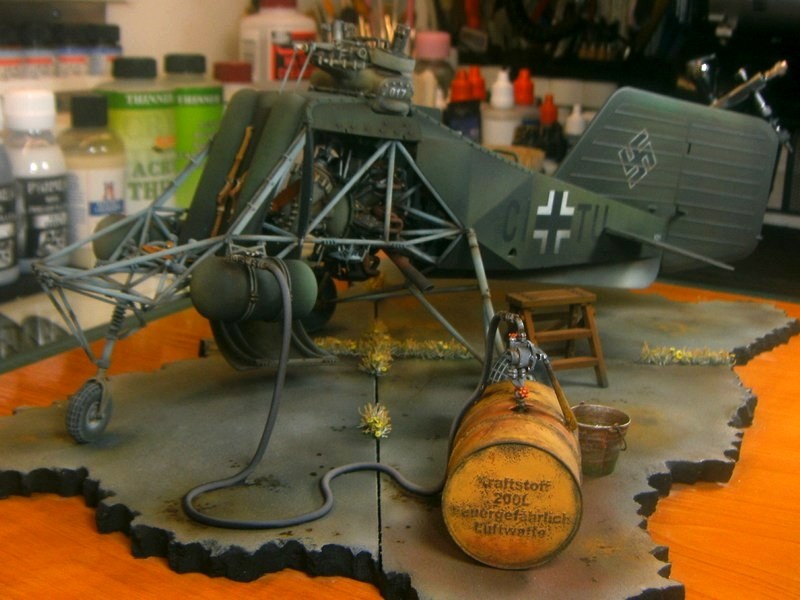
 Rivet counters may say that the presence of a 200 litres fuel drum right next to the helicopter may look unreal or too much. Well, considering that the twin seat Fl-282 V21 helicopter had two 25 litres cylindrical fuel tanks mounted externally on both sides of the pilot seat (while the main 105 litres fuel tank installed on previous versions removed to host observers rear seat), a number of only 2 or 3 fuel canisters could be just enough to do the job. I am not sure about the official refueling procedures followed by Luftwaffe for the Kolibri helicopter during operational conditions & which were the appropriate method followed by engineers & maintenance personnel. - Did they park the Kolibri close to area where 200 litres fuel drums stored and later pumped fuel directly into helicopters tanks through a hose? - Did they move (carrying on a truck / cart) the 200 litres fuel drums next to the helicopters parking area and later pump fuel inside tanks? - Did they fill helicopters tanks with hand-carried smaller 20 litres canisters & funnels, brought from main fuel storage area, next to parked Kolibri? IMHO, all the above (and many others) sound quite possible scenarios. Since we all have seen WWII era pics showing airfield ground personnel using a big variety of methods, from operating Opel refueling trucks, to mule / donkey driven carts or poor maintenance personnel carrying 20 litres canisters by hands, I think that having few 20 litres canisters left into the diorama scene and same time a 200 litres fuel drum feeding the helicopter tanks directly through a hose, could be considered as realistic and not just an artistic accepted option. 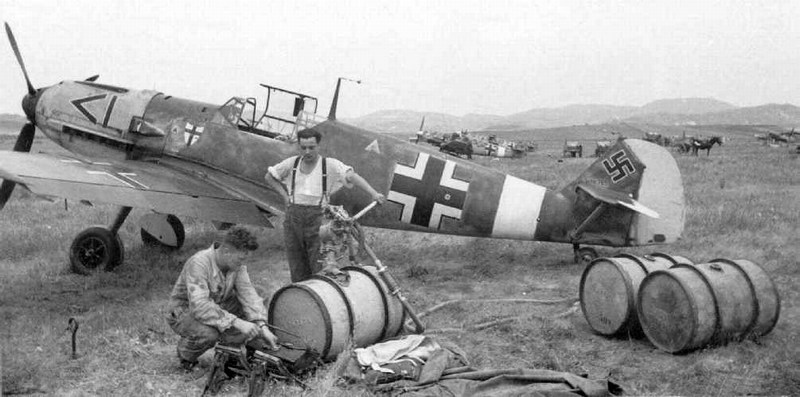
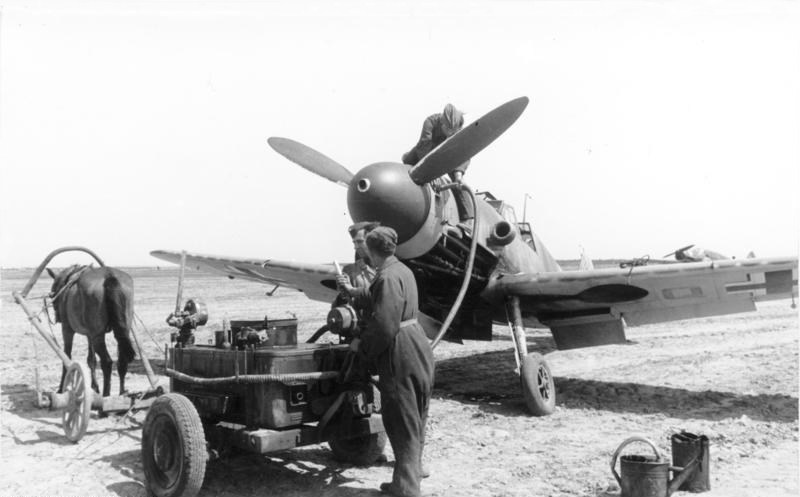
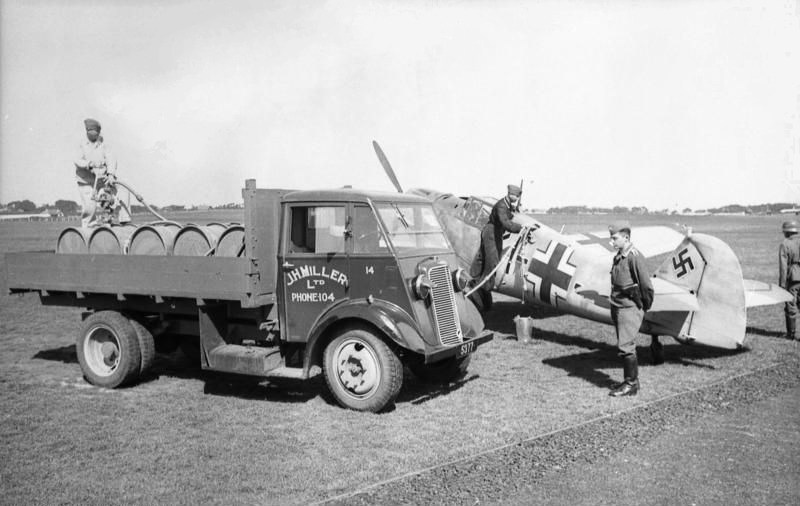 Meanwhile, the rotor blades for both versions attached on their rotor heads as described into the building manual (click HERE for the PDF formated file) through pages #88 to #94. Parts sprayed over with AK interactive AK768 primer to spot mistakes and prepare for paintjob. I did a visual inspection and shot some pictures. 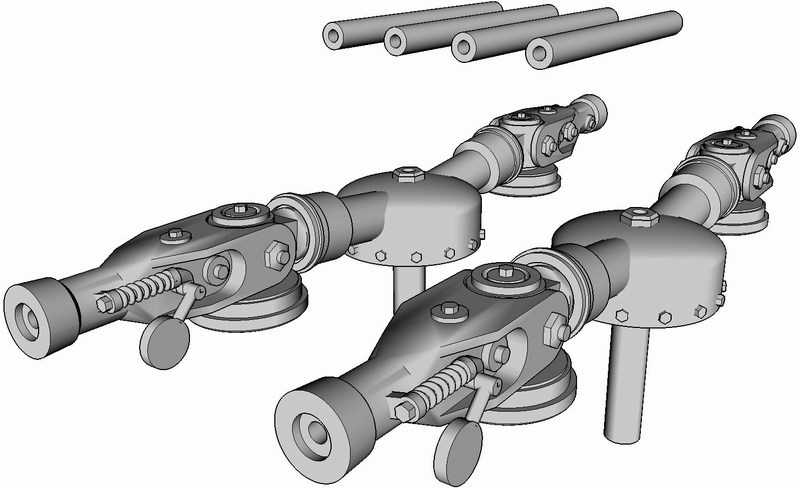
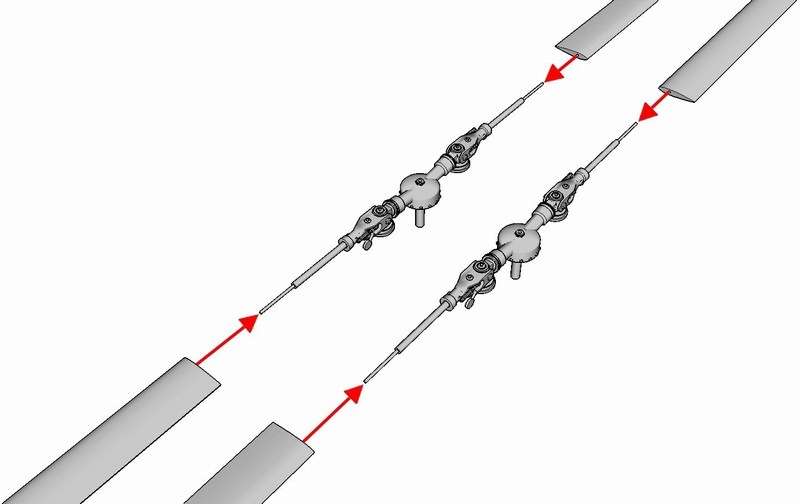

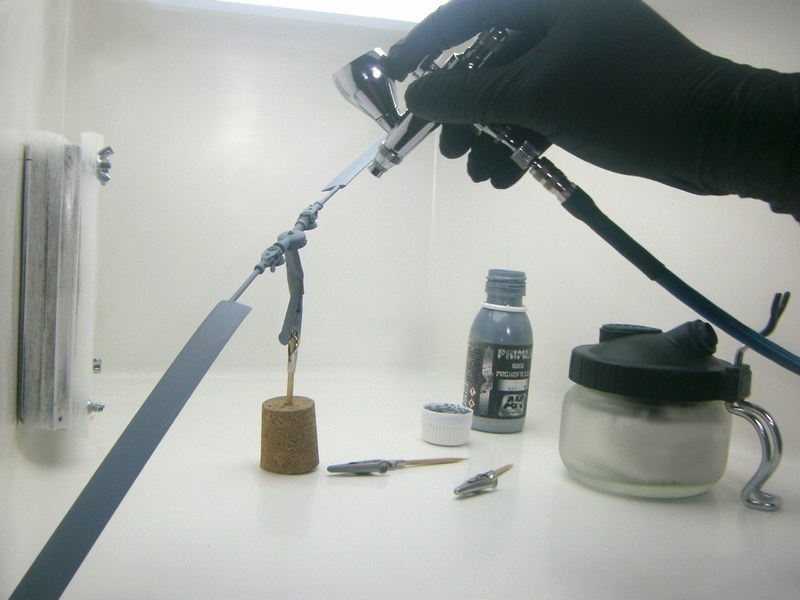 After overall primer, rotor blades dry fit tested to ensure that all individual components could be later combined together as an overall built model. I admit that its not easy to handle Kolibri scale model and find best angle for photoshoot on bench, while having the rotor blades (measuring approx 70 cm from one wingtip to the other) attached. 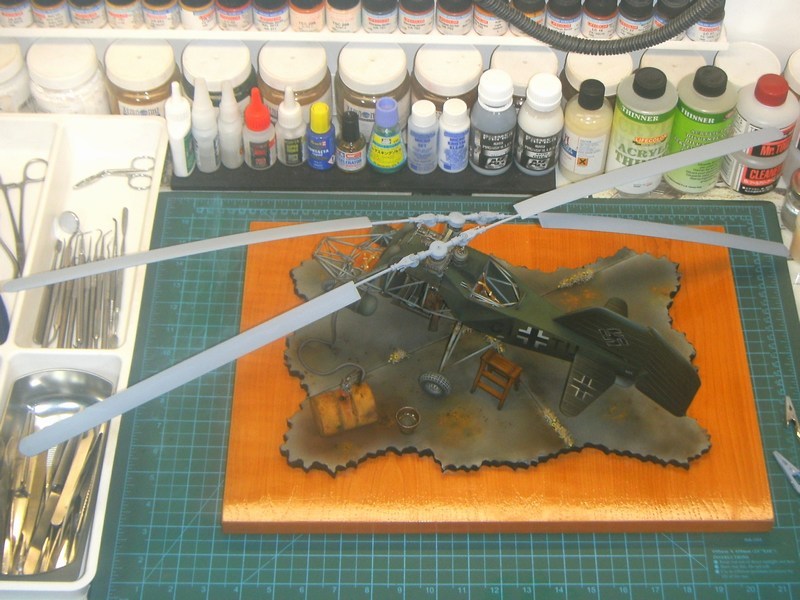 |
|
 |
|
| << Önceki Sayfa 4 |
  |
||
Forum Atla |
Kapalı Foruma Yeni Konu Gönderme Kapalı Forumdaki Konulara Cevap Yazma Kapalı Forumda Cevapları Silme Kapalı Forumdaki Cevapları Düzenleme Kapalı Forumda Anket Açma Kapalı Forumda Anketlerde Oy Kullanma |
|